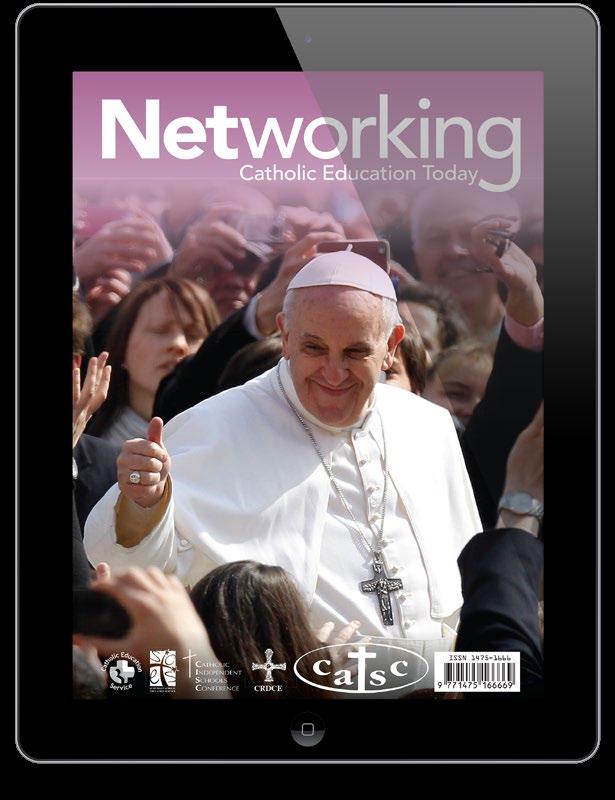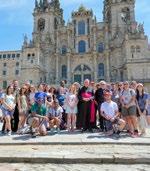






Where is the year going? It doesn’t seem that long ago when, back in January, we celebrated the Jubilee Year Launch Day for schools and colleges. A flurry of activity saw pupils and teachers across the nations came together to mark the start of this landmark moment in the Catholic church.
Inviting us to stand in solidarity with people around the world experiencing poverty, injustice and conflict, Pope Francis calls on us in this Jubilee year to be Pilgrims of Hope; to build a better world for everyone, experiencing the joy which comes from taking action together. It’s an invitation to renew our hope, a hope which comes from knowing God loves each one of us.

CAFOD, the Catholic Education Service and the Caritas Social Action Network have come together to provide you with a huge range of creative resources. They’ll support and inspire you and your whole school during this year of Jubilee.
For our Joint Resources Jubilee-schools.org.uk
Since January we have seen schools celebrate with many different activities: creating jubilee icons and proudly displaying banners, classroom talks and cross-town pilgrimage walks, painting windows and dressing in Jubilee colours.
“ We're delighted with how schools have responded to the Pope’s call to journey together with hope in this Jubilee Year ” says CAFOD’s Head of Education, Monica Conmee. “ The creativity and enthusiasm have been inspiring” she says.

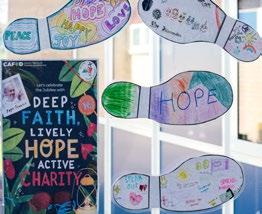
Encouraged by the success of the launch, it’s now time for the next stage of the journey. In June or July, all Catholic schools are invited to make a Jubilee Pledge to live out Catholic Social Teaching; to stand in solidarity with communities experiencing poverty, advancing justice and harmony locally, nationally, and globally.
A better world needs all of us, and the Jubilee Pledge will be a whole school, long-term commitment to take concrete actions to build a fairer world.
social action network


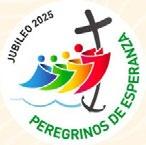






1. Four lines at the beginning state the pledge itself, which can be recited as a group.
2. The bullet points expand on the vision, detailing what it means to live out the words of the pledge.
3. The final part is over to you! Write down the ways in which your own school community will commit to living out the pledge in the long term.
1. Prepare the whole school community: learn about issues of injustice.
2. Consider how you will embed Catholic Social Teaching at the heart of school life in order to ensure a long-term commitment to building a better world. Write this on your pledge poster.
3. Choose a day in June or July to mark your Pledge Day.
4. Order or download pledge posters. You can order pledge posters from the CAFOD shop: shop.cafod.org.uk or download a copy from jubilee-schools.org.uk
5. Plan how to mark the day: liturgy, learning, activities, symbolic action. Find a suggested plan for the day online.
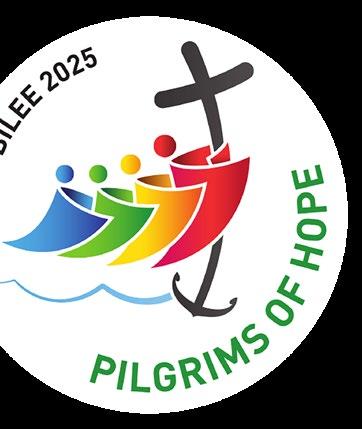
Download our Pledge Guide to help you write your Jubilee Pledge and plan your Pledge Day: jubilee-schools.org.uk

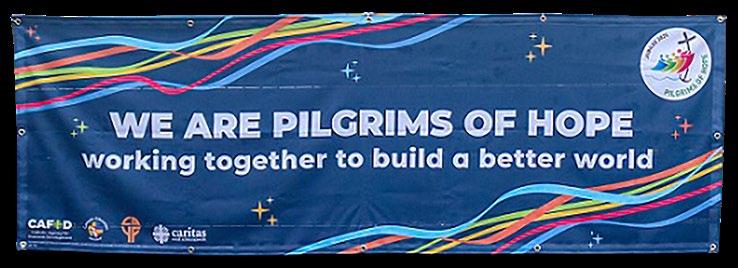
Pope Francis encourages us to celebrate the Jubilee with ‘deep faith, lively hope and active charity’. How we choose the Jubilee Pledge we make, and how we plan to live it out, can reflect all these things.

Use the 'See, Judge, Act' resource to help you identify areas that you wish to focus on for your whole school pledge. When preparing your pledge, work with CAFOD and your local Caritas to support the needs of your local community.
Once you’ve decided on your Jubilee Pledge, why not make it a day to remember involving the whole school community? You could celebrate your Jubilee Pledge Day with a Mass, Celebration of the Word or assembly incorporating Jubilee resources,
inviting parents and carers; send pledges home for families to commit to, together; explore issues of injustice through education resources on your Jubilee Pledge Day; have a celebratory fundraising coffee morning or afternoon.
In this Jubilee Year, all Catholic Schools are invited to refresh and renew their mission statement. If this is something you are considering, download the Vision, Values and Mission Toolkit for guidance.

social action network



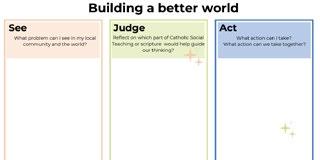

Raymond Friel OBE
Dr David Torevell
Rev Dcn Michael Bennett
Anthony McNamara
Edmund P Adamus
Jo Stow
Jessica Hall
Dr. Paul Rowan, PhL, STD
Declan Linnane
Dr Sean Whittle
Julie-Anne Tallon
As we began our summer term we did so with a profound sense of both gratitude and mourning. The death of our Holy Father, Pope Francis, marked the end of an extraordinary papacy—one deeply rooted in the Gospel and passionately committed to the mission of Catholic education across the world. In his quiet wisdom and courageous leadership, Pope Francis reminded us that education is “an act of hope” and called Catholic schools to be places of encounter, inclusion, and formation. He championed the role of educators as “builders of bridges,” urging us to form not only minds but hearts—especially among the young. His Global Compact on Education invited us to reimagine our vocation in solidarity with the poor, care for creation, and the pursuit of peace. We remember him now with reverence and resolve, inspired to carry forward the vision he so clearly articulated.
In this spirit of renewal, we’re pleased to highlight our newly updated website: networkingcet.co.uk. It has been designed as a more accessible and vibrant space for sharing resources, fostering dialogue, and promoting good practice among Catholic headteachers and educators. We are grateful to all who have contributed so far and warmly invite your continued support. We hope this issue will inspire and encourage you as we honour the legacy of a remarkable Pope and reaffirm our shared commitment to the Gospel values at the heart of Catholic education.


John Clawson Editor

By Raymond Friel OBE
Raymond Friel is a former headteacher in state Catholic secondary education. He is currently the CEO of Caritas Social Action Network. He is working on his next book, God’s Story: the Vision, Mission and Values of the Catholic School in the 21st Century, due to be published by Redemptorist Publications this autumn.
A knock on the door. it’s Monday morning in school, 8.28 am. Staff briefing is at 8.30 am. I’m fairly new in post as the headteacher of a Catholic secondary school, pacing my office, rehearsing my messages for the staff, some of them blunt. The atmosphere was edgy. Change was needed, but not everybody wanted change and I wasn’t all that secure about how to bring it about. I opened the door with a frown. It was Michelle, one of our young English teachers. “Have you got a minute?” she asked. I made it pretty clear I didn’t have a minute. Staff briefing was in two minutes and couldn’t this wait until later. But she held my gaze and quietly insisted. “I just need a minute.” So she came in and sat down and told me through tears that her sister who had two young children had been diagnosed with a terminal illness and she just wanted to know that she’d have some support from me.
I asked the deputy to do the staff briefing. We sat with cups of tea and she told me what was going on, while I listened, trying not to interrupt with the wrong words. I offered Michelle whatever help she would need to support her sister and her family in the difficult months ahead. She thanked me and went off to teach. Ten years later I left that school, and I got one of those very big farewell cards with dozens of scribbled messages from staff. There was a message from Michelle thanking me for the time I helped her when her sister was ill and had died. That was what stayed with her.
That taught me an important early lesson in leadership. Schools are very busy places and leadership in school is hard at times. You can lose yourself in the daily tasks and your attention can be dominated by the stressful situations and critical incidents you have to deal with. In a Catholic school, however, attention to each other should be at the heart of the mission, inspired by our vision of the human person, our anthropology, which is that we are made in the image and likeness of God. Made in love and for love, made to be relational, to grow in community, with a divine origin and an eternal destiny. The grandeur of this vision is sometimes hard to hold on to on a Monday morning in school. But it’s always there, waiting for us to re-focus.
Simone Weil, the great French philosopher, said, “Attention, taken to its highest degree, is the same thing as prayer. It presupposes faith and love” (1). Attention, like prayer, is a form of generosity. Weil called it the purest form of generosity. In some of the leadership courses in those days, there was a lot of focus on the importance of visibility. Be seen: in the corridors, the playground, the classrooms. That’s not unimportant, but it feels to me now too much like surveillance. Now I’d want to stress the importance of presence as a key characteristic of leadership in a Catholic school, indeed for any role. Presence as
a precondition for attention and encounter. In his homily for the opening of the synodal path, Pope Francis said, “Jesus did not hurry along, or keep looking at his watch to get the meeting over. He was always at the service of the person he was with, listening to what he or she had to say…We too are called to become experts in the art of encounter”(2).
These encounters with others are, If you like, sacramental. In On The Way to Life, a forgotten gem published by the Catholic Bishops’ Conference in 2005, the authors reflect on Vatican II’s theology of grace which “allows people to understand the sacramental nature of their ordinary lives, hence the universal call to holiness…In a sense, every member of the Church – not just the ordained priesthood and hierarchy – becomes a minister of grace and has the possibility of mediating it in and through their lives” (3), You won’t find that on many job descriptions for leaders in Catholic schools: ministers of grace. Yet, that is what we are, or can be. That is what we are called to be.
This is also sometimes referred to as the Catholic imagination, seeing presence where others see absence. As the same document puts it, “If grace is integral to nature, then all nature has in some way the capacity to disclose grace and be a vehicle of it.” This is the great insight at the heart of our faith, a profound understanding of the nature of graced presence: the presence of God in creation, the presence of Christ in those who experience poverty, the real presence of Christ in the Eucharist, the presence of the Holy Spirit among us today, prompting us from within to love God and to love one another. And presence, for it to become a transforming encounter, needs time and attention.
In the 21st century, one of the acute challenges we face is the ‘theft of time’, what Pope Francis, in one of his wonderful neologisms, calls rapidification. We are seduced by the culture of just-in-time delivery, instant response, the relentless pursuit of economic growth, with time spent just listening to each other considered a waste of time, unless it’s to extract information, or issue instructions. Leaders need time: for stillness, for reflection, for listening, for encounter. I can imagine many of the leaders I know reading that last sentence with a wry smile. Pull the other one, Raymond! I’ve barely got time for a sandwich at my desk, before I fire off a dozen emails and go and take assembly. Then there’s a knock on the door…
Endnotes:
1. Simone Weil, An Anthology (London: Penguin, 2005), p. 232
2. Pope Francis, Homily for Opening of Synodal Path (Rome, 10 October 2021)
3. Catholic Bishops’ Conference of England and Wales, On the Way to Life (2005)
How do pupils in our Catholic schools/ colleges/universities discover the Truth? In an age when the world order is being shaken to its core and when international and personal conflicts dominate the news, how do students discover who is right and who is wrong, who is telling the truth and who is telling lies? Is there any such thing as the Truth or have our pupils doggedly given up on answering this question? This issue is indelibly linked to students’ poor mental health and has produced according to Haigh (2024) an ‘anxious generation’ creating within them an ‘epidemic of mental illness’. They now inhabit a world saturated by international warfare, violence and killing, serious conflicts, AI, smartphones, social media ‘influencers’, neo-liberalism and rampant market forces. Haigh contends that social media and smartphones are the main culprits and that religion and sport give our young people two substantial ways out of their dilemma. Taking the religious exit, I shall focus in this article on the Trappist twentieth century monk Thomas Merton who offers one very practical way forward. I contend that Catholic educators should place his recommendations at the core of their thinking and practice. The practice is as old as Christianity itself; there really isn’t anything new here.
The Contemplation of the Natural Order and Truth
Merton was always concerned about Truth. In The Ascent to Truth he claims that the contemplation of nature and Truth, what the Greek Fathers and Mothers called theoria physica, is an illuminating recognition of God’s presence and influence in the world: ‘ … He is manifested in the essences (logia) of all things’ (McDonnell, 1989, 384, Ford, 2009). This is not a scientific knowledge of things, but rather an intuitive recognition borne of ‘… a habit of religious awareness’ (1989, 384). It is therefore likely to be enhanced over time, through prayer and contemplation. Indeed, Merton claims that this awareness comes about only by some degree of ‘ascetic detachment’, one of the key ongoing challenges involved in contemplative living. There is also another, illuminating side to this awareness (equally instinctive) which recognises the illusory and falsity of things when they are considered
wrenched from their right ordering and without reference to their Creator. In other words, contemplation allows us to ‘see’ the Truth of things when it is understood as ‘created’ by a benevolent God and at the same time to recognise illusion when this same creation is understood as unconnected to its source and its true purpose.
Contemplation counters the ‘Novelty’ and the Seeking of New Experiences Merton’s Biblical claim is that because ‘there is nothing new under the sun’, (Eccles, 1,9) scores of generations waste their time in endless pursuit of empty things, restlessly wanting new things, what Merton refers to as seeking ‘novelties’ (1989, 380) rather than accepting with appreciation what is given. Time spent on smartphones epitomises this pursuit. Filling time thus becomes an endless search for things which are empty (especially those based on sexual fantasy) and have no real substance – they quickly become non-existent, because they have no real existence in God. The best way to understand the world is to see it in relation to Christ who entered time and consecrated it to Himself and thus saved it from being ‘… an endless circle of frustrations’ (1989, 380). Contemporary men and women, as Merton so vividly describes, exhaust themselves ‘in the pursuit of mirages that ever fade and are renewed as fast as they have faded, drawing him further and further into the wilderness where he must die of thirst (1989, 380). Because of their lack of time given over to contemplation, they feel this alienation deeply. If the very reason for humanity’s existence is contemplation of the Father through Christ in the pursuit of Truth, then when a person finds s/he is unable or unwilling to do this, s/he goes in search of ‘… oblivion in exterior motion or desire’ (my italics, 1989, 382). Merton calls upon Pascal and his notion of divertissements (distractions) to defend his point: ‘We cannot find true happiness unless we deprive ourselves of the ersatz happiness of empty diversion’ (1989, 382). Because we cannot contemplate the world as we ought to, we fill our time with distractions which never ease our pain since these are empty and give no real, lasting comfort. In fact, they increase the pain because they trick us

By Dr David Torevell

into thinking they are real when in fact they are illusory; they tell us a lie which we are duped into believing is the truth. This reminds me of the Buddha’s second Noble Truth of which Merton would have been well aware. The craving for empty things brings about suffering, eventually leading to an experience of a dead-end.
But Merton offers a warning in his last collated publication before he set out on his Asian journey in 1968. He tells us that even if we do remember to contemplate, things can easily go wrong. When contemplation becomes essentially an insistent reflection on the self, it is nothing but narcissism and thus falls easily into idolatry. By simply studying ourselves (influenced perhaps by the many forms of contemporary secular forms of meditation which are now on offer and by the emergence of identity politics), practitioners may find this so ‘delightful’ that they lose interest in ‘… the invisible and unpredictable action of grace’ (2018, 35). Contemplation is not about establishing oneself ‘… in unassailable narcissistic security’ (2018, 9). Rather it is ‘… face to face with the sham and indignity of the false self that seeks to live for itself alone and to enjoy the “consolation of prayer” for its own sake’ (2018, 9). This so-called ‘self’ is pure illusion and he who lives by it will soon find ‘he experiences nothing but disgust or madness’ (1989, 9). Merton draws largely from existentialism and from Pascal. Our digital age, in its own insidious way, may promote this narcissistic and illusory way to the very limit. Since humanity lives with a sense of alienation, insecurity and ‘dread’ due to his/her inevitable, ceaseless self-questioning, the social realm tries to make it bearable when it offers ‘… a multitude of distractions and escapes’ (2018, 9). The banishing of Adam and Eve from the garden resulted in humanity’s disengagement from paradise (Gen, 3, 24). Attempts to assuage this alienation is revealed in those forms of modern addictions (sex, drugs, alcohol) which confront us in the news daily. But the answer is not to seek ‘answers’ by divertissements, but to contemplate the truths given by God in the created order. The way forward is Noverim te, noverim me (may I know you, that I may know myself), as St Augustine taught us (2018, 77). This is what brings a person rest and peace in the social order.
Instead of accepting the Stoics’ answer to painful events - learn to accept them as unflinchingly as you can - we should allow ourselves to ‘… be brought naked and defenceless into the centre of that
dread where we stand alone before God in our nothingness, without explanations, without theories, completely dependent on his providential care’ (2018, 80). Merton is postmodern in the sense that he sees that the modern autonomous self is an illusion and will crack under its own misapprehensions. Modernity’s insistence that individuals can secure a happiness for themselves by their own efforts, desires and motivations, becomes the greatest lie. Consequently, ‘… all our meditation should begin with the realization of our nothingness and helplessness in the presence of God’ (2018, 81). What is required is a disposition of humility, attention to reality, receptivity and pliability (2018, 83). The investigating cognito, which McGilchrist so convincingly exposes as an unbalanced left hemisphere brain activity, is recalled here. Since God is invisibly present to the ground of our being, he remains hidden from the ‘… arrogant grasp of our investigating mind’ (2010, 100). Any such attempts will fail. Merton claims he knows the very reason for our being born :‘… to be loved by him as our Creator and Redeemer, and to love him in return’ (2018, 102). This does not mean separating ourselves off from the material and the natural order, but of seeing its inherent potentiality and limitations so that they do not become idols. This recalls McGilchrist’s exposition of some of the dangers of the Protestant approach to images at the Reformation. Protestant iconoclasts could not see that divinity could find its place between one ‘thing’ (like a statue or stained-glass window) and another (the beholder) rather than ‘… having to reside fixed on the thing itself’ (2018, 316). If any images were allowed in the Reformation, it was because they could offer an explicit message ‘… by reading a kind of key, which demonstrates that the image is thought of simply as an adornment, whose only function is to fix a meaning … which could have been better stated literally’ (2018, 318). This reflected a far more cognitivist and literalist view towards reality than previously held and decried the value of metaphor for communicating thought. It also spurned a distinctively detached and suspicious attitude towards nature itself, which was reinforced by Descartes whose desperation to find certainty resulted in his belief that the only way to secure this was by developing a detached, mentalist and ‘objective’ view of the world. Thus, many became spectators rather than actors in the world, no longer bodily or affectively engaged with nature (McGilchrist, 2010, 332-335).
Hoff’s critique of techno-fascism and the iPhone culture in which we now live, rests on his view that our age is simply an extension of modernity and in particular Newton’s evaluation of the world as a machine. But our modern obsession with mobile phones and AI are particularly dangerous since the latest inventions tap into our senses and take on a quasi-sacramentality of their own. Mobile phones sing to us, we can touch its ‘holy’ screen and it looks suave and sophisticated – and what’s more, we can carry round this indispensable item in our pockets (2018, 254). They are very close to us; they mean a lot to us; they even define our identity. They are like someone’s else’s flesh next to ours - alive, consolatory, helpful, sexy - yet utterly, absolutely. different. Such modern machines (and that is all they are), have replaced our bodily absorption and attuning to the natural world. Merton would claim that they are another divertissement wrenching us away from contemplation and Truth. Persons are somatically cut off from one another in a new way, although such ‘new’ technology (we want the latest design, which is better and quicker and more efficient than the last) claims to make us more in touch with one another. Hoff writes, ‘Poorly designed technologies pollute our gift to be attuned to our never fully penetrable social and natural environment (2018, 252). Wise and prudent persons must never leave the task of finding the meaning and order of the world to software agents (2018, 259). Like McGilchrist’ summation of the contemporary world, Hoff claims that there persists a (post)modern narcissistic illusion to act as ‘… detached spectators, who hide behind a window or a surveillance camera, in order to observe analytically objectifiable “neutral facts” or more elementary “information units” ’ (2018, 267). Notice the present debate about the use of VAR in football and other sports. Video cameras are now consulted to determine the ‘truth’ of what happens in the spontaneous human vitality of a sporting match, one of the most bodily exercises known to humanity, where the ball swerves unreliably between flesh and other opponents’ flesh. The unexpected thrill of the game and human decisions made by the referee are now replaced by the detached watching of a video screen. But this fails since the human intervention of the referee has to interpret what the screen offers him. Machines can never tell the truth – at most they can nudge us in the right direction and even then
we have to be careful. We live in an age of sophisticated machines, which will increase as AI develops. They are on the march and there appears to be no stopping them. Care is required.
Giving Up on Contemplation leading to a Suspicion of the World
The reverse of a contemplative attuning to the natural order - what one might call a suspicious, cynical and even embittered attitude to the worldbecomes apparent in Shakespeare’s Hamlet. Once he can no longer trust the social world of which he is a part (the ghost has told him his uncle has killed his father), he becomes victim to and exposes a deeply jaundiced approach to that world. His soliloquy about the flatness of the world beginning with the famous semi-prayerful plea, ‘O God, O God, /How weary, stale, flat and unprofitable / Seems to me all the uses of this world!’ leads him to a more generalised condemnation of the world itself, sometimes expressed in gender terms - ‘Frailty, thy name to woman’. It expresses the belief that the world no longer has any significance or honesty attached to it, that the person he once loved is no longer to be trusted and that there is something ‘rotten’ in the entire state of Denmark’. Ophelia is right to say that ‘a noble mind is here overthrown’. Hamlet has lost his mind, or at least the mind he once had which could envisage the world in spiritual terms as good and created. It eventually leads him to doubt whether it is worth staying around this corrupt world at all– it might be better to not be, than to be. No amount of persuading by his mother to ‘throw to earth / This unprevailing woe’ will deter him from taking this stance towards the world, for she herself is caught up in the very conditions which make Hamlet believe as he does. The highly erotic description of his mother’s relationship with Claudius reflects his belief that lustful sex (‘In the rank sweat of an enseamed bed/Stewed in corruption …’, rather than love now constitutes the way of the world. Is the ghost real asks Hamlet to himself? But he also asks the more dangerous question – is the world ‘real’, ‘true’ ‘trustworthy’ anymore? And the only way he can answer this is by doubting and being suspicious towards any proclaimed substance to the world itself. Like the ghost, the world itself becomes insubstantial - nothing has any real substance anymore and he even wishes that his own ‘sallied flesh would melt/Thaw and resolve itself into a dew’; he wants to become insubstantial himself, just like the world he no longer trusts. He can no longer differentiate
between what is true and what is false, what is empty of meaning and what is full. He wishes to become a mirror image of the no-longer-to-be trusted world. Notice how he can no longer trust even himself anymore – not even to kill a foul murderer. Why not? He has lost confidence in himself and in the world.
Has Hamlet, like his postmodern heirs, decided that there is no longer any Truth to be discovered, or has he simply given up trying to find it in the murky world in which he finds himself? Has Merton’s ascent to Truth become too steep for him and for us? Gregory’s damning but persuasive appraisal of the contemporary world, in part initiated by Reformation thinking, is that we have relinquished the pursuit of truth. We are indoctrinated into the belief that there are no definite answers to life’s questions anymore (2012, 359). But this claim hides a paradoxical characteristic of modern liberalism. From a notion of tolerance, it does not prescribe what citizens should believe anymore, how they should live or what they should care about, but it nevertheless depends for its social cohesion ‘… on the voluntary acceptance of widely shared beliefs, values, and priorities that motivate people’s actions’ (2012, 375). Otherwise liberal states have to become more legalistic and coercive. Any trespass and the full force of the disciplinary law crashes down on trouble-makers.
Contemplative Learning
All of the above has consequences for the way we view learning. Griffiths makes a bold claim about how Christians ought to understand this Christian endeavour. This is at odds with contemporary emphases which makes an idolatry of the intellect. He believes the proper telos of learning has been sabotaged. We live in an age ‘… where the proper telos of learning is not virtue or contemplation, but, rather, material success and the attainment of power’ (my italics, 2011, 106). A Christian approach is to recognise that all knowledge is a route into the goodness of God’s creation. As Griffiths writes, ‘To know and think about anything – a theorem in mathematics … is to know something of what the Lord has made, which is to say that it is to know a good’ (2011, 106) He writes St. Augustine’s distinction between curiosity and studiousness is helpful here. Curiosita is a debased form of learning since it establishes a dominance, a power over that which is to be learned. We try to conquer it, master it and gain control over it - and therefore we abuse it. We enter into a form of prostitution where we have monopoly over a
‘thing’ for ultimately personal gain. One example of this is the nauseous claim that getting a degree (having knowledge) will ensure you get a wellpaid job. It is reductionist in the extreme. In this model, we make idols out of the things we learn. But as Griffiths intelligently and Merton-like points out, the phantasms that the curious attempt to grasp, do not satisfy them (2011, 128). Learning becomes desperate because such learners ‘seek new things to know because they can never be satisfied by the simulacra of knowledge curiosity provides’ (2011, 108). It is a Sysiphus-like nightmare, a walk into the abyss under the guise of gaining new knowledge. Can it even be called the gaining of information? Perhaps that is being too generous towards it. It is no less than an activity of the lust of the eyes claims St. Augustine. But, such a Faustian appetite for knowledge is paradoxically ravenous for its own extinction – it leads to death (2011, 108). The curious hate the unknown because they want to bring it to nothing by coming to know everything by an inappropriate means. But to bring the unknown (incognitum) to nothing by an act of blatant undisguised power, is to return it to the nothing from whence it came before the Lord brought it into being ex nihilo. God’s creation cannot be known in this way, for God’s creation is never mastered by his creatures. We do not have the capacity to know fully the things of God, and to reduce them to nothing, to not having any meaning or significance apart from financial gain, in the name of progress, is a selfcontradiction, but more dangerously, a lie to ourselves as created beings. It is to know ‘no-thing’ at all. Let me repeat, the endeavour is bound to fail, because curiosita, the method they use to gain knowledge of the unknown, guarantees a deathly failure to know. Indeed, all modern talk about methodology ignores the one centrally important core of learning – which is to approach learning studiously, contemplatively. Curiosity by contrast, brings about ‘cognitive devastation’, a shattering of the good, since its approach removes any chance of coming to know the unknowable; they are ‘cognitive killers’ (2011, 109). They murder Truth itself and then insist they are educated.
Studiousness (studiositas) is different and is based upon a desire for cognitive intimacy with and love for the created goods of God. All knowledge should be pursued primarily out of love for the world. And only secondarily for instrumental or functional ends. Only through the former can the secondary
be best determined. Griffiths tells us, ‘The studious do not assess outcomes or undertake their studies with particular expectations. Instead, we attend, lovingly, to what is given’ (2018, 119). Nothing is too small for our attention. Monks and nuns show us the way forward in this. Learning is a prayerful activity assisting to some small degree, access to the knowledge of God. That is why it is undertaken. We come to know God better when we learn. It is therefore a truly lifelong activity, since we can never come to know fully, the God who gave us his created goods to enjoy so that we might understand him a little more (1.Cor. 13,12). Studiousness often includes attentive waiting, sometimes a slow attuning to glimpses of truth which then spur us on to discover more. Delight in learning comes about because we develop an intimate relationship with the creative goods of God; it is never boring, might at times be arduous, but is never mind-sapping and debilitating. Learning about the things of God is actually quite difficult, especially when it comes to learning about ourselves. Since we are finite creatures dependent upon the Creator, we resist any attempts by others to figure us out, to know us. Studiousness also increases the status and importance of learning and tells us why it is vitally important in Christianity. Note how the Jesuits and Benedictines, for example, have a distinctive charism for learning. Monastics regulate their days by their absorption in prayer (contemplation), labour and learning. That is why their architectural features demonstrate a pattern around three interlocking circles - a chapel, a location for work and a library. Learning (or its proper form, lectio divina) cannot be separated from our desire for God.
Tuning into the World Contemplatively Tuning into the Truth might help us to understand better this issue. Jesus was the One who ‘fine-tuned’ his relationship with the Father through prayer. Merton says this is a delicate thing and we can easily be misled. Contemplative prayer if not properly conducted, can encourage the autonomous and calculating ego to be satisfied with and even take delight in its own narcissism ‘seeking to confirm itself in its own selfish existence’ (2018, 109). He then finds himself not alone with God, but with his own self. He will be in the presence of an idol of his own making. This is a false ‘nothingness’ for it rests content in its own finite being, and becomes ‘absorbed’ in its selfconstituted triviality’ (2018, 113). Real contemplation ‘is not a psychological trick, but a theological grace’ (2018,
115). What authentic contemplation does is to make us more attuned to our hope in God, our trust in his voice and our confidence in his mercy. This is not an ideological logic of equivalence‘emptiness equals the presence of God’. No. ‘An emptiness that is deliberately cultivated for the sake of personal ambition, is not empty at all: it is full of itself. It is so full that the light of God cannot get into it anywhere’ (2018, 119). This kind of ‘self-aspiration’ leads to the ‘emptiness of hell’. True contemplation is able to rest in ‘no-thing’ and it finds repose in emptiness but not emptiness for its own sake : ‘Actually, there is no such thing as emptiness, and the merely negative emptiness of false contemplation is a “thing” not a “nothing”. The “thing” that it is is simply the darkness of the self, from which all other beings are deliberately and of setpurpose excluded’ (2018, 120).
Sometimes Merton suggest the spirit of rebellious refusal persists in our heart even when we try to return to him (2018, 122). The ‘dread’ which occurs by being alienated from God and oneself (what better description is there of Hamlet’s state of being than this?) is set in rebellious opposition to the truth of one’s own contingency. If only Hamlet had realised this, then there would not have been so much blood. The realization of our contingent self also prevents us from having to say too harsh things about ourself (Pope Francis, 2018) Everyone fails; it also stops us from what Hamlet declares, ‘Now I am alone’. The experience of “dread’’, “nothingness” and “night” in the hearts of human beings is then the awareness of infidelity to the truth of our life (124). If reflects a deep lying to the self. It is an awareness of infidelity as unrepented and without grace as unrepentable (2018, 124). Merton claims that a feeling of nothingness will not be relieved ex opera operato by the reception of the sacraments. These will not suffice since s/he continues to cling to the empty illusion of a separate self, inclined to resist God. Nor will it ally his sense of nothingness which he will feel when left to him/herself without divertissement. He is even hard on ‘the best of men’ since they see ‘their stubborn attachment to the lie in themselves … their fear of truth and the risks it demands’ (2018, 125). Even if s/he is able to recognise the dread which comes about without recourse to God, at the same time s/he loses his conviction that God is or can be a refuge for him. His meditation then becomes nothing more than an agonia, a wrestling with nothingness and doubt.
St John of the Cross is Merton’s confidante and it should be Catholic educators’ too. When things appear dark and sinister in the world and when our prayer is arid and dry, like dried wood without kindle, then be glad for ‘when God takes your hand and guides you in the darkness, as though you were blind, to an end and by a way which you know not nor could ever hope to travel with the aid of your own eyes and feet, howsoever good you may be as a walker’ (St John of the Cross quoted in Merton 2018, 145).
What I have attempted to show in this article is that we can often become duped into thinking we inhabit a ‘real’ world, which through contemplation we learn is nothing more than a figment of our distracted selves. Pascal’s divertissements blur the boundaries between truth and falsehood and make the world opaque, sometimes insubstantial, often not to be trusted. This can lead to a kind of death in spiritual terms – the annihilation of Truth through the obliteration of the natural order as created. Merton and others like him, remind us of this. I believe it is wise for an ‘anxious generation’ to listen carefully to what they say.
References
Ford, M. 2009. Spiritual Masters for All Seasons.
Gregory, B. 2012. The Unintended Reformation.: How a Religious Revolution Secularised Society.
Griffiths, P. 2011. ‘From Curiosity to Studiousness-: Catechising the Appetite for learning’ in Smith, D & Smith, J. Teaching and Christian Practices. Reshaping Faith and Learning.
Haidt, J. 2024. The Anxious Generation. How the Great Rewiring of Childhood is Causing an Epidemic of Mental Illness.
Hoff, J. 2018. ‘The Eclipse of Sacramental Realism in the Age of Re-Form: Rethinking Luther’s Gutenberg Galaxy in a Post-Digital Age’, New Blackfriars. 99. 1080. 248-270.
McDonnell, T. 1989. A Thomas Meton Reader. McGilchrist, I. 2010. The Master and his Emissary. The Divided Brain and the Making of the Western World.
Merton, T. 2018. Where Prayer Flourishes. Pope Francis, 2018. Gaudete et Exsultate. Apostolic Exhortation on the Call to Holiness in today’s World.
David’s co-written book with Brandon Schneeberger and Luke Taylor SJ Exploring Catholic Faith in Shakesperean Drama. Towards a Philosophy of Education was published by Routledge in April, 2025.
Introduction
The 2016 GCSE curriculum reforms led to a tsunami of change in all areas of the KS4 curriculum. These changes were so profound that McGrail & Towey (2019) conducted an impact study in eighteen schools across various Dioceses in England and Wales. The study, entitled Partners in Progress? An Impact Study of the 2016 RE Reforms in England, sought to understand the views of teachers and leaders of RE in the Catholic sector. Using a qualitative methodology, gathering data through in-depth semistructured interviews, the study showed that whilst the changes were positively greeted by many, there was a high degree of dissatisfaction among practitioners who viewed the content as inappropriate for many GCSE students. It was believed to be inaccessible and irrelevant to their lives or stage of development in their faith journey. Although the study conducted student focus groups, the findings did not include this data. Thus, there is a need to understand how students experience the reformed KS4 RE curriculum.
Is the Reformed Curriculum Accessible and Relevant?
As a practitioner of RE for twenty-eight years, I find the 2016 curriculum problematic. I agree with McGrail & Towey (2019) that areas of the reformed content lack relevance to the lives of many students. Having delivered the GCSE in three schools, each with different socio-economic contexts, I have experienced similar student reactions: ‘Why do we have to learn this?’ and ‘This is boring!’ Many practitioners I have worked with, and others through professional networks, voice similar concerns. One colleague commented that the curriculum, even within an approved examination board, lacks relevance and is ‘out of touch with the reality’ of students.
McGrail & Towey (2019, p.283) found dissatisfaction among teachers who felt the curriculum ‘would be too difficult for pupils’ due to its overly academic theological content. A significant cause of dissatisfaction was also the level, quantity, accessibility, and language of the content (p.288). These are strong criticisms. If educated professionals with a vocation to teach RE express such concerns, it raises the question: what are the students' opinions?
This question has prompted me to undertake an EdD to explore how GCSE RE students experience the curriculum, which equates
to 10% of their curriculum time. In a synodal Church that values listening and discerning, it is timely to understand student experiences of the RE curriculum, considered not only a core subject but the "core of the core curriculum" (St. Pope John Paul II, 1992, p.2).
In this article, I explain why, in the spirit of synodality, it is important to explore how Roman Catholic GCSE RE students experience the curriculum.
Why My Study? A Tsunami of Change! 2016 marked a massive shift in England and Wales's GCSE curriculum, described as a "headlong rush to reform GCSEs [leading to] widespread confusion" (Bousted, 2017, p.1). This was not the view of Michael Gove, who based the changes on Michael Young's (2014) theory of powerful knowledge. Gericke (2018, p.428) argues that for Young, "Powerful knowledge is coherent, conceptual, disciplinary knowledge that, when learned, will empower students to make decisions and become actioncompetent."
For Young (2014), powerful knowledge transcends common knowledge and leads individuals from what they know to what they do not yet know. It exists outside students' immediate experiences, providing access to new worlds. In RE, for example, knowledge of the Magisterium would be considered powerful knowledge.
Is Powerful Knowledge a Problem? The simple answer is ‘No’—a curriculum should present new knowledge specific to each discipline. In English, studying A Christmas Carol and Macbeth moves students into new yet relevant worlds: concepts like greed, poverty, illness, and loneliness remain within their thematic universe.
In RE, Moffat (2021, p.249) argues that powerful knowledge can offer "deep learning," stating that the RE specification provides academic rigour appropriate to students’ age, offering a lifelong love of theology. Yet, one must ask: is the RE GCSE knowledge different from English in terms of student comprehension? Is the RE curriculum relevant to students' lives?
These questions drive my desire to explore student experiences. When asking students who consider RE boring whether they find
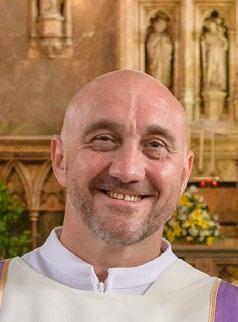
By Rev Dcn Michael Bennett
Dcn Mike Bennett is the Director of Catholic Life at All Saints RC High School Kirkby Liverpool. Having served in six Catholic Schools in the Archdiocese of Liverpool for over twenty-fiveyears as teacher of RE, Head of RE and Assistant & Deputy Headteacher. Mike is currently leading on Catholic Life and formation. Mike is in the final stage of a Doctorate at Liverpool Hope University researching students' experiences of GCSE RE Specification A.
other subjects more interesting, many suggest English feels more relevant. Why? Bellet (2006) applies a theory from Paulo Freire (1970), a Brazilian educator and philosopher who developed critical pedagogy.
Freire’s thematic universe theory argues that knowledge disconnected from the learner’s reality is hard to grasp. In adult literacy, he refused to use standard government texts, instead using materials rooted in students' environments. In terms of RE, Bellet (2006) suggests that knowledge must exist within the student's thematic universe—the world of ideas they inhabit.
Thus, while A Christmas Carol resonates with students, can the same be said for studying the Four Marks of the Church? I do not yet know, but I aim to explore this.
Some students view the post-2016 RE curriculum as irrelevant. Is it because much of the knowledge lies outside their thematic universe? I cannot yet answer this; however, students' voices must be listened to.
Synodality
We are called to be a synodal Church, valuing listening. Pope Francis (2021) teaches that the Church is on a constant journey, and at its heart is the synodal process—a "learning process, in the course of which the Church comes to know herself better" (p.5).
We must engage with students of RE: if they express dissatisfaction with the curriculum, we must discern its meaning; if they find it engaging, we must celebrate that.
In my experience, students more positively embrace philosophy content— particularly moral philosophy or Christian ethics. Debates around human sexuality, reproduction, and gender discrimination seem to engage students more fully. Is this because these topics lie within their thematic universe and offer concrete points of reference for anchoring new knowledge?
In contrast, theological and scriptural content appears less relevant to many students, possibly because it does not exist within their thematic universe. A Religious Education curriculum must offer engagement with the Church's traditions and wisdom. Yet, is the current weighting toward Theology and Scripture too heavy? Should there be greater balance with Philosophy and
Ethics? These are questions I will explore during my research.
Over nearly thirty years, I have seen a change in students' attitudes since the 2016 reforms. Many students question why they must learn about topics like the Four Marks of the Church, the Magisterium, and Popular Piety. Many colleagues also struggle to make these accessible to fifteen-year-olds.
Chater (2015), Gericke (2018), and Deng (2015) argue that a highly academic theological curriculum that exists outside students' immediate experiences will lead to frustration. Chater (2015, p.5) particularly suggests that a content-laden curriculum tends to "induce boredom, apathy or hostility amongst students and teachers!" I have experienced this many times since 2016.
Thus, it is apt to build on McGrail and Towey’s (2019) work. Their study considered the impact on those who deliver the curriculum; now, it is time to assess its impact on those who receive it.
Methodology
My research focuses on subjective human experience: how students experience the curriculum they receive, and how teachers experience delivering it. I aim to assess differences between what is taught, what students would like to learn, and what teachers would like to deliver.
Using a qualitative methodology, I will gather data through in-depth, semistructured interviews with RE students and teachers. This approach will allow me to fully understand participants' experiences. I will analyse the data using Interpretative Phenomenological Analysis (IPA), which seeks to understand the complexity of human experience.
Conclusion
McGrail and Towey’s (2019) impact study was a timely and significant piece of research. It provided RE teachers and leaders in Catholic schools an opportunity to discuss their experiences of the reformed GCSE curriculum, highlighting both satisfaction and dissatisfaction. A key anxiety was the suitability of the content and its potential to disengage students due to lack of relevance and accessibility.
Although students’ views were gathered during McGrail and Towey's study, they were not published. Nine years on, it is time to engage with students directly, in a spirit of synodality, to understand their experience of GCSE Religious Education.
References
Bellett, E. (2006) Religious Education for Liberation: A Perspective from Paulo Freire. British Journal of Religious Education, 20(3), pp. 133-143.
Bousted, M. (2017) The consequences of Gove’s ideological reforms are now being felt everywhere’. Times Education Supplement.
Chater, M. (2013) Doing the Knowledge: or, I had that Mr Gove in my curriculum once.
Chater, M. (2020) Reforming RE: Power and Knowledge in a worldviews curriculum. John Catt Publications.
Deng, Z. (2015) Content, Joseph Schwab and German Didaktik. Journal of Curriculum Studies, 47(6), pp. 733-786.
Dillen, A. (2011) Empowering Children in Religious Education: Rethinking Power Dynamics. Journal of Religious Education, 59(3), p 4-16.
Franck, O. (2021) Gateways to accessing Powerful Knowledge: a critical constructive analysis. Journal of Religious Education, 69(6), pp. 161-174.
Franck, O. (2023) Powerful Knowledge in Religious Education: Exploring Paths to a Knowledge-Based Education in Religions. Palmgrove Macmillan.
Freire, P. (1970) Pedagogy of the Oppressed. Penguin.
Freire, P. (2005) Teachers as Cultural Workers: Letters to those who dare to Teach. Routledge.
Gericke, N. (2018) ‘Powerful knowledge, transformations and the need for empirical studies across school subjects’. London Review of Education, 16(3), pp. 428–444.
Lundie, D. (2009) ‘Does RE work?’ An analysis of the aims, practices and models of effectiveness of religious education in the UK. British Journal of Religious Education, 32(2), pp. 163 -170.
McGrail, P, Towey, A. (2019) Partners in Progress? An impact study of the 2016 Religious Education reforms in England. International Journal of Christianity and Education, 26(3), pp.278-298.
Moffatt, J. (2021) Religious Education as a Discipline in the Knowledge Rich Curriculum. Irish and British Reflections on Catholic Education, Springer pp. 249-260.
Pope Francis (2021), Pope calls for humble and synodal Church, led by the Holy Spirit, Vatican News Service.
Pope John Paul II (1992), ADDRESS OF HIS HOLINESS JOHN PAUL II TO THE BISHOPS OF GREAT BRITAIN ON THEIR AD LIMINA VISIT.
After nearly two decades of headship in Catholic education, I work as a consultant. My main areas of interest are school leadership and how appraisals are conducted, especially the appraisal of heads and the CEOs of MATs. This includes how NC assessments, OFSTED inspections and other measures of school performance impact on appraisal outcomes. I’m increasingly aware of the importance of fairness, empathy and understanding in appraisal conversations, including whether the professed ethos or charism of a church school is always being reflected in the experience of the person being appraised. At all levels, appraisal should be treated as a significant process with conversations that are constructive and targets that are both challenging and motivating. In some cases, however, they are treated as a cursory administrative necessity. Managed poorly, they can be a deflating experience for the appraisee. My interactions with trustees, governors, CEOs and heads have given me insights into the strengths and limitations of different appraisal models.
The core purpose of appraisal is to review performance based on the outcomes of agreed targets and to agree on objectives for the following cycle. Most panels and line managers recognise, however, that outcomes are unlikely to reflect the entirety of the appraisee’s performance and will take a holistic view of the quality of their leadership. Targets for school leaders may range from being remedial, such as strategies to address concerns raised by an inspection, to groundbreaking, perhaps spearheading a major curriculum or pastoral innovation. They can be detailed or broad brush. In a church school at least one will focus on its Christian life. Whatever way they are framed they should prioritise rather than add to leaders’ workload and their challenge should be manageable. A target which has a focus on, and strategies for, improving teaching and learning is essential, but its desired outcome should avoid pinning success on a specific percentage or numerically based outcome. Although appraisal objectives for heads are termed as ‘governors’ targets’, in my experience
panels generally trust competent leaders to draft their key priorities for the following cycle. Where relationships are good and communications are regular, these will likely be accepted as an appropriate starting point. However, before any formal agreement on targets, modifications suggested by panel members are a positive indicator of mutual respect and shared empowerment.
An effective relationship between the external consultant and an appraisal panel is based on respect for each institution’s preferences and policies for the format for the review. Consultants can propose modifications which panels often welcome, but appraisal processes should be challenged only when they are clearly problematic. Alongside their experience and expertise, consultants bring their own distinctive approach to undertaking the role. It is best for this to be shared with governors or trustees before being appointed. I follow the ‘appreciative enquiry’ model, a robust and constructive evaluation process promoted by the National College for School Leadership. I’ve also learnt much from effective appraisal strategies used by the outstanding educationalists I’ve observed in my work for the NCSL’s International Unit. Longitudinal research by Nottingham University’s Professor Chris Day into effective leadership has shown how heads who lead the same school successfully over several years provide a desirable blend of continuity and openness to change. Consultants who work with leaders and governors over longer periods develop a richer understanding of a school’s story, its challenges, and the aspirations it has for itself. Coupled with the rigour essential for avoiding a ‘comfort zone’, this empathy and trust allow for better informed and more searching professional conversations.
Although there will always be some heads who lack the skills and personal qualities needed to do the job, most leaders are committed to ensuring the wellbeing of their pupils and staff and to improving outcomes, so enabling their schools
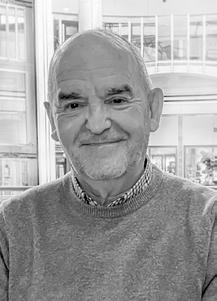
By Anthony McNamara
to flourish. Conversations between leaders and consultants in the run up to appraisal provide valuable opportunities to discuss pedagogy, analyse data, reflect on performance and relationships, and explore possibilities for the future. Many schools hold termly or midacademic year appraisal meetings so progress against targets can be monitored on an interim basis. The annual appraisal meeting itself, however, is the most significant arena not only for trustees and governors to review and assess the school leader’s performance in a summative way but also, just as importantly, to record their support and appreciation for the person in whom they have entrusted the leadership of their MAT or school. While recording panel members’ comments on progress against targets, I ask each of them to say what they most appreciate about their head or CEO. The praise is invariably heartfelt, as is concern for the leader’s wellbeing. Many consultants ensure that these comments, perhaps anonymised, are captured in the final document. Seeing an appraisee’s face glow when they listen to how much a panel values their hard work and commitment is a lovely moment.
Working over several years with primaries, secondaries and MATs in both the state and church sectors in different parts of the country, I’ve seen how the appraisal process is enriched by the quality of panel members. On rare and dismal occasions, because of insensitive or even unprofessional behaviour, I have had to intervene. I needed to prompt one chair of governors to thank a head who had met all her targets and was held in high regard by her colleagues. A more disturbing experience was having to challenge a CEO who, in front of an appraisal panel, made unjustifiable and deprecating comments about a committed and effective head. In some larger MATs, there are notorious cases of a setback such as a drop in KS4 results being used as a cudgel. The appraisee is left with their confidence shattered and a resignation that may be a loss to the profession. These poorly or badly managed appraisals are wasted opportunities for what could have been transformational professional exchanges.
Where concerns and challenges have arisen over the year, appraisal conversations and reflections that are handled with sensitivity can be catalysts for improvement. I have been inspired
by the deep emotional intelligence shown by some chairs and CEOs in years when pupil outcomes have been disappointing. When I used this adjective in my preliminary notes to the CEO of a high achieving MAT in reference to results in one of his schools, he challenged me. He felt it carried unhelpful freight and risked being internalised by the head concerned as personal failure. I listened as he reflected truthfully to the head how the year had gone. He did not excuse or gloss over anything but throughout the conversation what I heard was his understanding of context, and his confidence in and respect and affection for his colleague. The head told me how reassured and motivated he felt afterwards. The warmth and drive for excellence that characterise that MAT have transformed the life chances of children in the deprived area it serves, and its success has deservedly attracted national attention.
The effectiveness of school leaders is rightly measured against national terms of reference and so their appraisal should give significant weight to pupil progress and attainment and inspection judgments. Context matters as well: results and attendance can be affected by difficulties in recruitment, poor quality supply staff, long-term staff sickness, and persistent absenteeism among pupils who are unreachable. Widespread concerns over the validity of inspection judgments and the behaviour of some inspectors have prompted a government review. At a conference on school improvement in Brazil I saw for myself how the heavy-handedness of the OFSTED model of quality assurance is why it continues to be an unattractive international outlier. A speech by HM inspector of Schools appalled many of the delegates and differed starkly from the supportive vision offered by Canadian and Australian speakers. Conversations that followed raised two questions: ‘How do we measure, assess, inspect and appraise intelligently?’ and ‘How do we employ emotional intelligence effectively in appraising and supporting our teachers and school leaders?’.
Appraisal objectives, when achieved, provide evidence of their positive impact. But whatever the capacity in which we work in schools, our daily interactions, professional behaviour and priorities are being appraised all the time, and most importantly by our
pupils. In the context of a 2022 PISA survey which showed that our young people have the second lowest life satisfaction in developed countries, and another which ranked them among the highest for ‘not feeling they belonged’, one objective set for all of us who work in Catholic education overrides all others. It is ongoing and challenging and is why many of us see our work as a vocation. Our pupils may not be aware we are trying to achieve it, but in these darkest of times, and especially for those who are most vulnerable and disadvantaged, it will shape their future lives. It was best described in the Vatican Council document, ‘Gaudium et Spes’. It called on school leaders and teachers ‘to be especially aware of how much depends on them in the present state of the world. Their task is not simply to impart knowledge but to give future generations reasons for living and hoping’.
This is a huge and daunting expectation on us. In most cases it will be met in small shifts in awareness and behaviour which have a cumulative impact. Here is an example from my own experience. One year we trialled an anonymous survey with the classes we each taught which included the sentence, ‘My teacher likes me’. I was upset to see that among the thumbs up and don’t knows, one pupil had ringed ‘no’. From the handwriting I eventually worked out who the child was. To my shame I realised that he wasn’t imagining it, I probably didn’t like him and what worse, he knew it. That appraisal of me, a circled ‘no’, by a child who was struggling with his learning jolted me into developing a greater awareness of my own behaviour. It motivated me to improve my practice more than any panel scrutinising my performance. It made me reflect as well on the damaging impact two teachers had had on my self-worth when I was a schoolboy and how a line-manager who never hid his dislike for me at the start of my teaching career undermined my confidence. In whatever capacity we interact with others, the emotional intelligence that we acquire through learning empathy and self-awareness will be a key driver to improving performance. More importantly, it will do its bit to make Amos’ and Micah’s call to ‘act justly and love tenderly’ a reality. As the saying goes: ‘We might forget what was said to us, but we’ll never forget how we were made to feel’.
The perception that faith and science are at odds remains stubbornly prevalent in some circles. The prominence in the early 2000s of New Atheists, such as Richard Dawkins and the late Christopher Hitchens, strongly contributed to this misconception.
Historical awareness can be limited. The likes of James Clerk Maxwell, Johannes Kepler, and Georges Lemaître, the Belgian priest who proposed the “Big Bang” theory, are among many who felt that theism was not at odds with the pursuit of scientific knowledge. For Lemaître, his faith engendered the awe that inspired his research. Nevertheless, more recent debates — in the West, at least — have all but eclipsed this multilayered history.
It is in this sometimes fraught context that the UK-based “God and the Big Bang” education programme came to be. In 2010, the Anglican diocese of Manchester submitted a motion to the General Synod, affirming that science and faith were compatible. The motion passed with little opposition.
Two years later, the Director of Education for Manchester diocese, Maurice Smith, and the Anglican Bishop of Middleton commissioned social entrepreneur , Michael Harvey, to begin a project that would demonstrate this compatibility. Despite having no science background himself, Mr Harvey was undaunted.
“I found a head teacher in Kent who, with a couple of scientists, arranged events for sixthform students called ‘God and the Big Bang’. I thought it was something quite replicable, asked for permission to use the name, and brought it back to the diocese of Manchester. From those beginnings, more than a decade ago, God and the Big Bang (www.GATBB. co.uk) has become a nationwide project, involving dozens of scientists of deep Christian faith, many of whom are Catholics who have spoken to tens of thousands of primary and secondary school students as well as sixth form students since its inception. In 2023 alone, the team visited more than 100 schools, and interacted with more than 6500 nine- to 18-year-olds. Around 15% of schools who host the workshop are Catholic schools and the GATBB Team are eager to be invited by more. In recent weeks both the newsletters of ATCRE [Association of Teachers in Catholic Religious Education] and CISC [Catholic Independent Schools Conference] have generously advertised the workshop. David Bayne,
Communications lead for ATCRE and a retired Head of Sixth Form in Hexham and Newcastle diocese experienced the workshop himself with his own students and highly recommends it.
THE team offers schools a series of formats, depending on age. “Awesome Science” sessions, for five- to seven-year-olds, last between one and two hours; workshops for eight- to 11-year-olds can be offered as either a half or whole day; for 11- to 18-year-olds, workshops are offered over a whole day, divided into various interactive segments.
Workshops are designed to be flexible, to work around a school and its needs. Pupils are surveyed at the start, to help the team to adapt accordingly. Classes may reflect on meaty subjects such as evolution, ethics, science in action, whether medical treatment is a human right, or how to decide what the NHS offers patients. Another questionnaire is distributed at the end of the day to see what impact the experience has had.
Mr Harvey believes that the programme is redressing some important historical imbalances in the ways in which both science and faith have been approached in British education. He feels, as do many in Christian schools that “scientism” has crept in to all areas of education. ‘This is what science has found, and it will basically solve all the problems,’ he says , ‘ very rarely do we teach science as “This is what we don’t know.”
“Often, there’s a sense from schools that parents are either worried we’re coming in with a very evangelistic agenda - which we don’t - or that we’re going to tell them that they must believe in evolution and the Big Bang” explains Abi Falkus Lead Coordinator.
As well as the in-person workshop in school, “God and the Big Bang” is accompanied by online resources — many of them free and suitable for audiences of diverse ages, disciplines, and beliefs. A highlight is the video Sparks Resources — which accompanies purchases of Sparks discussion cards — where the team discuss weighty matters such as “God and Creation”, “Truth and Proof”, “Time and Space”, and “Mystery and Wonder”.
“Questions are at the heart of both science and religion,” a biology and physics researcher, Gavin Merrifield, another member of the team, says. “If we stop asking questions, I think then we have a problem.”
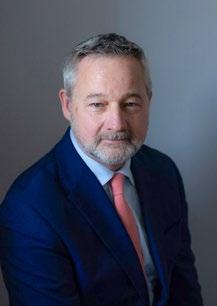
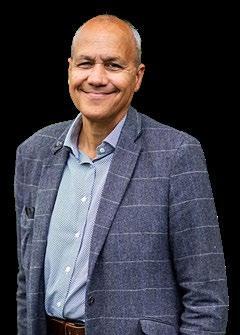


I recently attended a full drop down day workshop at St. Thomas the Apostle Academy in the Archdiocese of Southwark for the whole of Year 11. [Yes Year 11 in their GCSE year!] I was very impressed by the way the team enabled the students to really engage with the process and explore the interconnectedness of faith and reason/ science and religion. Rob Green, Head of RE said;
“Students at St Thomas the Apostle are very STEM orientated but a large majority do have a strong faith as well. Finding activities that incorporate the two can sometimes be quite difficult especially in a formal setting. However, GATBB incorporate these two aspects of life really well. I think the students responded well to how professional and interesting the speakers were. The team had a great passion for their chosen specialities, and I think this kept the students engaged throughout the day. Staff members were equally as impressed in the Q&A as the team seemed to tackle the questions fantastically.” As an observer on the day, I can fully attest to this highly positive impact. The GATBB team recently carried out some research in to the impact of their work in a Catholic secondary school and the key findings were that students with religious commitment (especially Muslims & some Catholic and other Christians) defended faith, while atheist/ agnostic students unsurprisingly leaned towards science. KS3 students were more uncertain, while students in KS4/5 had nuanced views. Many believed faith and science could coexist once they had experienced the workshop strongly agreeing with the statement: "Science explains the physical world, faith explains meaning."
How does GATBB scout for talent?
“The key word is scouting”, Mr Harvey says. “We’re blessed if people come to us. In the meantime, we actively seek out highly committed Christian undergraduates and post-graduate scientists as it’s important that our facilitators are relatively close to secondary students in age.”
GATBB is thus about far more than shattering the dichotomy of faith v. science. It is about equipping young people with important skills, such as discernment and critical analysis, useful for academia and beyond. Students are learning to apply knowledge constructively, to engage in, and with, the wider world better. This is all the more vital in a “post-truth society” where it seems to be completely unacceptable to tell somebody that they’re wrong, even if what they believe to be true is based on misinformation. After more than a dozen years of being in schools the fruits are beginning to show. Michael tells me this is exemplified by a recent encounter. “There was a young man, who was in his first term at Oxford, studying biology. A senior scholar said to him: ‘You’re a Christian doing biology? Then you won’t be a Christian after the first year.’ The young man said it shocked him a bit. However, he remembered, just a few months before, a group of GATBB scientists came to his school showing that science and faith were compatible.’” These are the kind of bright young minds that Michael hopes to bring on board in future. “We’re going from recruiting 10 to 30 science communicators in one year. We’ll have to find, train, and deploy them, and that’s going to really test us.”
In 2021 GATBB was a awarded a three year grant of £707,000 from the John
Templeton Foundation which is testimony to as well faith in the unique educational contribution the project is making and why Catholic schools would do well to engage with GATBB as much as possible.
The aim is to help students explore how faith and religion together helps us ask better questions in harmony with scientific knowledge and discovery through the lens of Christian spirituality and biblical faith. Many children, don't always appreciate just how much the Church has been an advocate for scientific discovery throughout history and just how many amazing scientists were men and women of profound Christian faith.
The workshop aids the mission, identity and evangelisation role of the school by raising awareness of just how proscience the Church is and has been as well as alerting young people to the risk of scientism. [placing an excessive belief in the power of scientific knowledge and techniques]
Students are challenged to think critically as they approach questions from both a scientific and faith perspective. The content is carefully tailored to the age and ability of the pupils taking part.
Scan Here
For a brief video providing some information on the GATBB project
Or visit: gatbb.co.uk
If you would like to know more and book a workshop for your school please contact Abi Falkus on abi@gatbb.co.uk
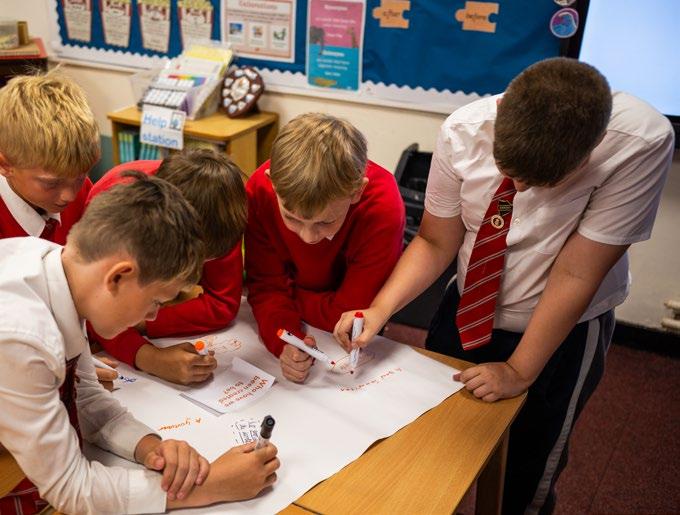
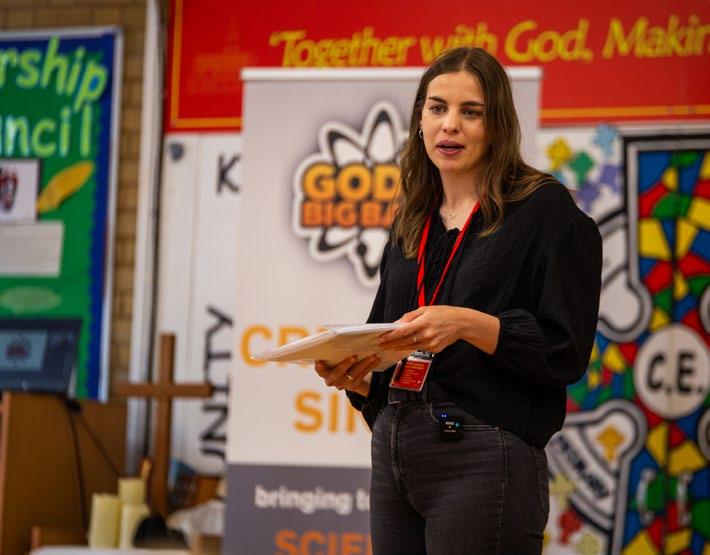

As we reflect on the season of Lent that has just passed, Common Good Schools Project Leader, Jo Stow, encourages schools to take a more relational approach to charity and to notice hidden poverty in the classroom.
Last week, I joined a friend who is a teacher at an after-school club. The children gathered, enjoyed snacks, and then went off to participate in the session’s activities. After snack time, I noticed that one boy, Michael (not his real name), hung back from the activities and was eating what was left over of the snacks. Michael is eleven. His teacher added quietly, “He comes for the free food.”
The season of Lent was a busy one in church schools. Charities were supported. Wonderfully creative, sponsored events took place. Children and staff worked hard to “give alms to the poor.” Donations were made to local food banks. Many fasted – a spiritual discipline that points us to God by reminding us how it feels to be hungry,
At an education conference I recently attended, data was shared about child poverty globally. A teacher spoke up. He said, “Students at my school are part of that statistic.” I went to chat with him over lunch. He spoke about the stigma of poverty in schools. “These children become invisible because of the shame they feel. Somehow, they feel that poverty must be their own fault.” I was struck that stigma is still an issue after decades of campaigning on child poverty. These children are effectively hidden in plain sight. We have the data, but part of the story is missing.
Now that Lent has ended, it is worth reflecting on where the poor people we have supported are located—where they live: nearby, in another district, or perhaps overseas.
Lately, I’ve been doing some research among primary school teachers. It became




engage with issues of global poverty, but there is a considerable lack when it comes to the local. Given this, what could we be missing? Perhaps our approach needs to pay closer attention to context. And when we support a local charity, we should be aware that some of those in need may be under our own roof.
Them
Let’s consider the full meaning of almsgiving. Traditionally, giving alms has been described as “a witness to fraternal charity”[3], indicating that it is about more than giving money or services. Christian love particularly involves the gift of time and personal connection. This is how the bonds of fraternity are formed.
Pope Francis repeatedly called for a culture of encounter and warns against charity becoming a means of keeping poor people at arm’s length.[4]
In a busy school, “almsgiving” can sometimes become reductive and conflated with fundraising. What might this feel like for Michael? His ability to contribute is compromised, and his family’s situation can become a source of shame. He is faced with the confusion of being invisible in his own classroom.
If we fail to embrace the true spirit of almsgiving, we can inadvertently fall into a “them and us” dynamic. If we do not recognise who is under our roof, we create a false division between those who can afford to give and those who can’t, and we risk removing the agency of someone who is poor.
In its welfarist, reductive form, where charity is understood as volunteers doing charity for poor people (whether through fundraising or by delivering a service), the possibilities of true encounter are small. The transactional dynamic between active giver and passive recipient does not build fraternity, one of the signs of Christian love.
If our almsgiving is focused on our local area, this opens up opportunities to go beyond the welfarist approach. A mark of the common good
is reciprocity. This requires true relationship, where there is give and take, and the dignity of the person is upheld. Simply giving money to the poor may help temporarily, but it does not uphold a person’s dignity – it is as if he or she has nothing to contribute.
Earlier this week, a colleague shared with me some children’s responses to the question “Do you think God cares about poverty?” Most assumed that God does care, and that kindness is the right response. But rather a lot of them took the view that poverty is a matter of fate or the result of poor choices. There was little awareness of the injustice of an economic model that relies on low-wage, insecure jobs.
The Christian vision of justice derives from the Jewish tradition of right relationship, in which the response to poverty must be relational. We do not stand in solidarity with the poor by giving a handout and walking away.
The principle of Solidarity sees human beings as social beings designed to be interconnected by relationships of mutual concern and support. It is a determination to work for the good of all and of each person – so that in some way, all are responsible for all.
This means going through something with someone, giving time and building a relationship, helping them to get back on their feet. The Good Samaritan not only helped the man by the road and paid for his care; he came back the next day. A relationship was formed.
Charity that is truly Christian is not a one-way street: the giver must be open to receive, and the receiver must be able to give. This ensures a mutuality that goes beyond transaction. Everyone has something to contribute.
In Catholic Social Teaching, Solidarity is always to be balanced with the principle of Subsidiarity. Subsidiarity holds that responsibility is taken at the most appropriate level and that decisions should always be taken closest to those they affect – and that a central authority should only do tasks
that cannot be performed at a more local level. In this way, everyone fulfils their unique roles, and the integrity and agency of each person are upheld.
If Not Donations, What Might This Look Like?
We often ask our partner schools, “How can you make what you are already doing more common good?” Small tweaks are where to begin. For example, fundraising should always be accompanied by something relational and reciprocal. Whatever your Lent action was, it should have built relationships.
If you are open to a radical new way of almsgiving, consider these suggestions:
• A shared meal hosted by a local partner with a good kitchen, served by school children (both those on FSMs and those who are not), involving parents and staff, and where members of the community are invited too. Costs could be supported by a pay-asyou-feel or pay-it-forward model.
• A listening project where children research what sorts of foods are available locally – identifying whether fresh, healthy food (fruit, veg, meat, and fish) is priced too high, and finding out about the range of local suppliers, including supermarkets, community food sources, co-ops, allotments, and local farming produce.
What About Michael?
Michael, the boy who stayed for the leftover snacks, is not just hungry - he is isolated. For him, school charity initiatives were confusing and embarrassing. Beyond FSM statistics, Michael deserves solidarity, friendship, accompaniment and the opportunity to contribute..
Now that Lent is over, how can we ensure that our charity work builds relationships, respects dignity, and fosters reciprocity?
In an era where the social landscape is increasingly secular and pluralistic, Catholic independent schools face a unique set of challenges. These schools are tasked with remaining true to their religious identity while simultaneously providing a contemporary, high-quality education that resonates with the broader society. At Beaulieu Convent School in Jersey, which I have the privilege of serving as Head, and in my role as Chair of the Catholic Independent Schools Conference, I have been fortunate to witness first-hand how Catholic schools navigate these tensions while continuing to serve the needs of our diverse communities.
Our Catholic ethos has never been more relevant or important. Yet, as we work to attract students and staff in this competitive educational marketplace, we must ask ourselves: How do we make our faith-based approach relevant to all members of our community, particularly those who may not share the same religious convictions? And how can our distinctive Catholic identity serve as a unique selling point in a crowded field of independent schools?
The cultural shift toward secularism in Western societies is evident in many aspects of our lives, from the diminished role of religion in the public sphere to the decreasing number of people who actively practice their faith. This secular tide has not passed by Catholic education, and our schools must respond to these societal changes while remaining steadfast in their mission to offer an education rooted in Catholic virtues.
As Catholic educators, we are called to ensure that the teachings of the Church inform the whole curriculum, from science to the arts, from history to sport. Catholic schools are not simply about imparting academic knowledge but also about fostering a deep sense of moral and spiritual formation. Yet, in a secular age, it is challenging to communicate the relevance of these values to students and families who may not see their significance.
One of the most significant challenges Catholic schools face today is engaging parents and students who may not practice the faith but still seek an excellent educational experience. For these families,
the decision to send their children to a Catholic school may be more about the quality of education or the moral framework the school provides, rather than a desire to immerse themselves in a faith-centred environment.
This shift in perspective is not necessarily negative, but it does require Catholic schools to articulate clearly what they stand for. Catholic independent schools must answer: "What makes us different from other schools, and why should you choose us for your child?"
Catholic schools offer a unique opportunity for students to grow not only in academic knowledge but also in virtue. The heart of Catholic education is the integration of faith and reason, the recognition that human knowledge, in all its forms, should be informed by the teachings of the Church. It is in this integration that we find the true strength of our schools.
Catholic independent schools are dedicated to ensuring that the Catholic faith is at the centre of everything we do. We believe that a Catholic education helps develop students into compassionate, morally responsible citizens who understand the importance of serving others. It is through acts of service, through reflection on our core beliefs, and through a commitment to justice that we create a vibrant community rooted in faith.
In a world increasingly driven by materialism, competition, and individualism, the emphasis on serving others, promoting social justice, and valuing each individual as created in the image and likeness of God is a vital counterpoint. Catholic schools are uniquely positioned to offer a model of education that nurtures the whole person—mind, body, and spirit—while teaching students that success is not merely about academic achievement or financial prosperity, but about how one lives a good and virtuous life.
Furthermore, in a world that is often divided, Catholic schools stand as beacons of unity. Our schools are places where people of all faiths and backgrounds can come together to learn, grow, and deepen their understanding of the world around them, while remaining rooted in the shared belief in human dignity and social

By Matthew Burke
responsibility. These values transcend religious boundaries and have the potential to resonate with families from a wide range of backgrounds.
A key aspect of Catholic education is the way we function as small parishes within our wider communities. The sense of community in Catholic schools is not just about academic achievement, but about the living out of the virtues we hold dear: faith, hope, charity and justice to name but a few. These virtues are embedded not only in our curriculum but in the way we interact with one another daily, creating a nurturing environment where these qualities are cultivated in both students and staff alike.
In our small, close-knit Catholic school communities, we have the unique opportunity to help our students form their character in a way that goes beyond the classroom. Through spiritual formation, pastoral care, and opportunities for service, we have the chance to instil in each student a deep, lasting sense of moral responsibility. We encourage students to embrace these virtues, not simply as abstract ideals, but as lived realities that will shape their decisions, actions, and relationships throughout their lives. These virtues become a part of who they are, a foundation on which they will build their future.
At Beaulieu Convent School, like all Catholic schools, we are proud to offer students the opportunity to engage in regular acts of service, which can be transformative in the way they view the world. Whether it is helping those in need in our local community or engaging in global initiatives, we foster a spirit of giving and compassion. These experiences create a lasting impact on students, instilling within them a commitment to justice, peace, and the common good. This embedded culture of virtue not only helps our students grow as individuals but also strengthens the fabric of our school community.
Another unique aspect of Catholic education is the charism of religious orders, which adds a special dimension to the life of schools that are closely associated with religious congregations. Religious orders bring with them a unique spiritual heritage, a set of practices, and a deep commitment to the mission of the Church that profoundly shapes the culture of Catholic schools.
For schools with religious orders attached, such as Beaulieu, we are blessed with the legacy and charism of the Sisters of the Immaculate Conception. Their enduring commitment to education, their profound faith, and their dedication to serving the needs of others imbue our school with a sense of purpose and mission that goes beyond mere academic excellence. The charism of the Sisters shapes not only our curriculum but the way we approach pastoral care, student development, and community outreach. It is a gift that continues to guide us in our work with students, staff, and parents.
For schools with a religious order connection, the charism adds a depth of spirituality and a living tradition of faith that enhances the experience of all who are part of the school community. It is more than simply a religious tradition; it is an active, dynamic force that brings a sense of unity, purpose, and direction to the school, aligning us with a broader network of schools and communities around the world who share our commitment to the values of the Catholic faith.
This distinctive charism is a powerful tool in the recruitment of staff and students who are aligned with our values. Teachers and staff who are drawn to Catholic education often seek the opportunity to work in environments where the charism of a religious order is central to the school’s identity. It provides them with the opportunity to be part of a vibrant, faith-filled community that not only educates but also nourishes the soul.
As competition among independent schools grows, one question on the minds of Catholic schools is how to differentiate ourselves from the rest of the field. What makes Catholic independent schools stand out in a crowded marketplace? The answer lies in the distinctive Catholic ethos we offer, which, if communicated effectively, can be a powerful tool in both student and staff recruitment.
For parents, the Catholic ethos offers the promise of an education that will help their child grow academically, socially, and spiritually. But it also assures them that their child will be part of a community that emphasises moral integrity, respect for others, and service to society. In an age when many parents are concerned about the
pressures their children face in a world increasingly focused on material success, a Catholic school offers an alternative—a place where virtues and character development are prioritised alongside academic achievement.
Moreover, the Catholic ethos is not limited to religion classes or chapel services. It permeates the entire school experience, shaping how we approach discipline, how we engage with students, how we teach our curriculum, and how we foster a sense of community. At Beaulieu, for example, our commitment to Catholic social teaching underpins everything we do, from promoting environmental sustainability to supporting the marginalised.
But the Catholic ethos is not only a draw for parents and students—it is also a strong selling point when it comes to staff recruitment. Teachers who are passionate about their faith often seek out schools where they can integrate their beliefs into their teaching. For them, Catholic schools offer a meaningful and fulfilling career, where they can contribute to the development of students who will not only excel academically but also grow in virtue and character.
Catholic schools have a unique opportunity to attract staff who are committed to the mission of the Church and who are eager to serve in a community that shares their values. The ability to live out one's faith in a school environment can be incredibly rewarding, and it is a quality that many educators are actively seeking. By emphasising our distinctive ethos in recruitment materials, interviews, and outreach, Catholic schools can attract high-quality staff who share our commitment to developing the whole child.
While the Catholic ethos is a powerful tool for recruitment, it must also be understood that the Catholic education landscape is not static. We must continuously adapt to meet the changing needs of our students and their families. This includes not only embracing innovation in teaching and learning but also making our schools accessible and inclusive to a wider range of people.
The challenge for Catholic schools is to balance the deep, rich tradition of our faith with the demands of modern education. This is not always easy.
Parents and students increasingly want schools that prepare students for the challenges of the future—particularly in terms of technology, global awareness, and career readiness. Catholic schools must remain nimble and responsive, integrating cutting-edge educational practices while staying true to their roots.
For example, at Beaulieu, we are continually exploring how best to equip our students with the skills they need for the 21st century—whether through fostering digital literacy, offering opportunities for international experiences, or ensuring that our students are prepared for the workforce. Yet, throughout all of this, we remain grounded in our Catholic values, which ensure that we are not simply producing students who are academically successful but also individuals who are
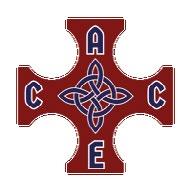
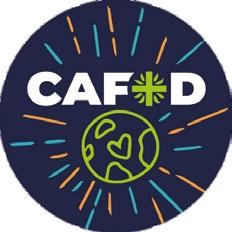
compassionate, ethical, and committed to making a difference in the world.
The challenges facing Catholic independent schools in a secular age are real, but they are not insurmountable. In fact, they present an opportunity for our schools to renew and strengthen their commitment to their distinctive ethos. By continuing to engage with the broader community, by articulating the unique value of a Catholic education, and by attracting staff and students who are aligned with our mission, Catholic schools can thrive in a secular world.
At the heart of Catholic education is a deep commitment to the formation of the whole person—mind, body, and spirit. This holistic approach is as relevant today as it has ever been. In a world that often prioritises success at
any cost, Catholic education offers a compelling vision of what it means to live a truly fulfilling life—one that is centred on faith, virtue, and service to others.
The distinctive Catholic ethos we offer is not just an asset; it is our strength. It is a powerful tool for recruitment, a way of differentiating ourselves in a crowded marketplace, and a promise that, no matter the challenges, Catholic education will remain a beacon of hope, faith, and love in a world that so desperately needs it.
As we look to the future, let us embrace the challenges with confidence, knowing that the values we hold dear are more essential than ever in shaping the leaders, citizens, and faithful individuals of tomorrow.







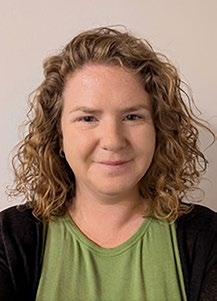
In the complex and seemingly everchanging landscape of Catholic education, one thing, we can be sure, remains certain: the commitment to a wholistic education. The idea of mind, body, and spirit nurtured and cared for, with a focus on faith development, and the aim of bringing young people to an encounter with the person of Christ remains steadfastly at the heart of Catholic education.
As with all things, however, the ways in which we strive to establish this encounter with the person of Christ, have changed and developed with time. But the fundamental principle of working to bring all people into relationship with the person of Christ has not.
One of the many ways in which Catholic schools and colleges may seek to foster this relationship with Christ is through the ministry of Chaplaincy.
The shape and role of the school Chaplain has changed considerably over the last few decades. It has changed from being predominantly clergy to largely lay, from isolated pockets to growing networks across schools, Trusts and Diocese. It is a ministry that is alive and growing.
Though working within thriving school communities, Chaplaincy can at times, be a very lonely role. As a school Chaplain you are often the only person within the staff body doing your role, a role that bends and shapes to minister to needs of the people in front it. Meaning that there are often as many understandings as to what a Chaplain actually does, as there are people within the staff body. There are though, as mentioned previously, growing networks of support. Chaplains working within Trusts liaise regularly in an effort to bring cohesion across the Trust, Diocesan Coordinators aim to gather their Chaplains together on occasions throughout the year, ensuring the vision of the Diocese is understood through its schools and colleges. And The Association of Catholic Chaplains in Education (ACCE) reaches across all of these to offer a
national picture of Chaplaincy, working to promote and support the establishment and development of Chaplaincy provision in all schools and colleges in England and Wales.
Over the last 25 years, ACCE has grown and developed alongside the ministry of school Chaplaincy. The Association offers support and a wider network to Chaplains, both lay and religious, to those members of staff not employed at Chaplains, but with an added responsibility for Chaplaincy and more recently to many of those now named as Prayer and Liturgy Coordinators within their schools or colleges.
The Association of Catholic Chaplains in Education is a national association and sits independent of any one specific diocese. It is managed by a National Co-ordinator, who is in turn supported by an Executive Team and a Supervisor from within the membership.
Although an independent association, ACCE maintains strong links across the Catholic education networks and as such, reports termly to the Bishops Conference of England and Wales and meets regularly with the Catholic Education Service (CES). These relationships are twofold; on the one hand it offers a platform for the thoughts and concerns of the ACCE membership to be shared with and heard by those who bear a responsibility for Catholic Education in England and Wales. And on the other, it allows the Association to hear directly the vision for Catholic education taking shape across England and Wales and giving Chaplains a voice within this vision.
The Association of Catholic Chaplains in Education has grown to be a platform for its membership to be heard by, and hear from, other agencies involved in Catholic education and in working with young people, agencies such as CYMFed, the CES and the Bishops’ Conference. And within this framework ACCE is well placed to continue to challenge those issues affecting the ministry of Chaplaincy. Issues
such as the professionalism of the role, the standardisation of pay scales and expectations of the role, both the joys and challenges for many Chaplains of taking on the role of Prayer and Liturgy Coordinator, and the growing concerns around mental heath in the UK.
The primary role of the Association of Catholic Chaplains in Education, however, remains the development and support of its membership throughout England and Wales. Therefore, alongside being an advocate for Chaplaincy, allowing its members voices and concerns to be heard by others, the ACCE takes time to listen to its membership itself and respond to its needs.
As a result of this ACCE is there for both individual Chaplains and for whole school communities in times of crisis or need, with the ability to offer practical help such as resources and advice, but also to be a form nonmanagerial support.
As a result, the Executive Team produce a half termly eNewsletter that is issued to all members. These communications usually comprise of an update from the National Coordinator, informing the membership of some of the ‘behind the scenes’ elements of the Association, such as meeting with various agencies or reports submitted, an update on upcoming
events, a spiritual thought or reflection from one of the Executive Team and a body of resources generated by the Exec and those members who wish to contribute.
ACCE also aims to offer at least one online CPD a year, this began with six sessions on the Prayer and Liturgy Directory and plans are in the making for training on other issues raised by the membership such as a Pastoral Approach to Gender Identity and Sexual Orientation and Practical Support for Bereavement. These online sessions have been a recent addition to the work of ACCE and came about organically as a response to the framework for the Catholic Schools Inspectorate.
ACCE also seeks to support Chaplains nationally, not only those within its membership. Therefore, things such as online CPD are offered at a discounted rate to members, while still be open for non-member Chaplains or key staff within schools and the same applies for the Annual ACCE Residential Conference. In recent years, the ACCE Executive Team have strived to find a location in one of the more central dioceses and this year the ACCE Conference will be held in Northampton Diocese, at Highgate House in Northamptonshire.
The 2025 ACCE Conference boasts a great line, opening on the Wednesday
afternoon with The Carlo Acutis National Apostolate leading us through a similar experience as they might lead in schools, educating us on the life of the young saint, sharing testimony from those who knew him, including his mother and finally guiding us in prayer to close our evening together. Thursday will be a change of pace, with David Wells delivering a keynote speech. As it is the midpoint of the Jubilee Year, our keynote speech will focus on that idea of hope. In the afternoon we will be joined by various charities and organisations to lead us in workshops, from Aid to the Church in Need, to Prayer Spaces UK to CAFOD to name but a few. ACCEs aim is always to offer both food for the spirit, but also something practical that can be taken back into schools. And as if the workshops were not enough, on the Friday morning we will be joined by SVP who will be leading us in prayer and sharing their Jubilee resources including those for the restart in schools and colleges in September.
The Executive Team would love to welcome you to the ACCE Conference and if you have any questions or queries about either the conference or the work of ACCE more generally please do feel free to contact us on exec.acce@gmail.com.


By Dr. Paul Rowan, PhL, STD
Paul was ordained a priest for the Archdiocese of Liverpool in 1995. He has been on the academic and formation staff of 3 seminaries, in Rome and the U.K. He has taught and been involved in pastoral and chaplaincy work in primary, secondary and tertiary education, which has included pontifical and secular institutions. He is currently an Assistant Head (Director of Catholic Life and Formation) at Beaulieu Convent School Jersey in the Channel Islands.
In his message for the World Day of Prayer for Vocations (which takes place this month, 11th May, Good Shepherd Sunday), Pope Francis writes, “A vocation is a precious gift that God sows in the heart…It is a call to go out of ourselves and begin a journey of love and service.” Note that the Holy Father points out that the one vocation we all receive in this world is to love and serve others. This is in response to our having first been loved into existence by God and placed on the stage of history in a drama with others who have been loved into existence. We each have to find our own particular, specific and indeed unique ways to incarnate that vocation to love. This is no easy discernment task for any of us, but amidst the economic, social and spiritual challenges of our world, young people can sometimes feel especially lost. “They often experience uncertainty about job prospects and, more profoundly, an identity crisis, which is also a crisis of meaning and values.” The Holy Father has said that this sense of feeling adrift is made worse by the “confusion” of digital culture and the violence of war and injustice; yet God remains present, calling each person by name and inviting them to live with purpose. [1]
Perhaps it is because so many young people often feel adrift without purpose, subtly influenced by the massaging messages of social media and other external cultural factors, that Pope Francis has suggested that education itself is an act of hope.
We know the transforming power of education: to educate is to invest in and give the present the hope that breaks the determinisms and fatalisms with which the selfishness of the strong, the conformism of the weak and the ideology of the utopian want to impose themselves so often as the only possible way. [2]
For Pope Francis, education must offer, inter alia, a vision that challenges young people to realise that the way things are in the world is not inevitable. In the very first book of the Bible, in which sacred myths try to communicate truths about the origins of present realities, we discover that human beings have something of God’s nature in them, a spark of free will by which they can conform to or act against God’s will, thereby going with with or against the grain of reality. Human actions always have consequences - the good things that exist can be spoiled, but some of the evil that we experience in the world need not necessarily be so. Catholic education needs to be resolute in proclaiming the gospel message of hope, that under God’s grace we can be co-creators of a better future.
This academic year Beaulieu Convent School Jersey has been running a series of evenings under the banner Beaulieu Insights. Each evening has centred on a talk designed to support the parent community in our own school and beyond. We have invited a group of experts to address topics raised by parents and which are key issues for the flourishing of young people in school and beyond. On 19th March this year Dr. Aric Sigman [3], a leading international children’s health expert, talked about the issue of vaping and its dangers for young people. Towards the very end of his presentation, he said that he was not himself a religious man, but remarked that there is a growing body of statistical evidence to suggest that young people who are religious are much less prone to picking up addictions. In the Q&A part of Dr. Sigman’s talk, I mentioned a vague insight rattling around in the back of my mind and which I knew to be from somewhere in Viktor Frankl’s book Man’s Search for Meaning. Frankl says that addiction often arises because
one is living a life without meaning. I wondered out loud if the frameworks of interpretation provided by overarching metanarratives (such as, but not limited to the ones found in religious traditions) might therefore be a factor in the data being considered. Sigman said that on his bedside in the hotel where he was staying lay this core text of Krankl and that he would now have to return and seek out the relevant section.
The Jewish Scriptures said it thousands of years before Frankl: “Without a vision, the people perish.” [4] Are, as Pope Francis seems to suggest, some young people today themselves in danger of becoming bored, rootless and anchorless because they feel without a vision (a metanarrative)? Are they at risk of finding life meaningless and so end up having to look for ways to fill their emptiness with dependencyforming sources of amusement? Like Frankl, Wittgenstein also says that authentic meaning and happiness flow from thinking and living in harmony with something deeper and greater than ourselves: “In order to live happily I must be in agreement with the world.” [5] In this year in which we are called to be “Pilgrims of Hope”, have many of the young people entrusted to our care concluded that life is ultimately hopeless because it is meaningless, because they sense that there is nothing deeper or greater than themselves and the present moment? No ultimate overall story or drama of which they are part? I do not wish to suggest for a second that all young people think like that, nor that they are inherently selfish. On the contrary, the idealism and the capacity for generous loving service of others [6] has always been one of the more remarkable qualities of younger generations (even if some of them then go on to learn the bad habits of their elders and settle for “the way of the world!”). No, young people are no more egotistical than in previous generations and so many of them are full of goodness and integrity. But if some of them struggle to see beyond the surface of the world, to sense something deeper and greater, it is because the whole cultural context for
being able to do that has changed. It is more difficult to sense and then trust a metanarrative nowadays because young (and not so young!) people have inherited a kind of confusion or doubt from the pressures around them. They are constantly kept on the go, drowning in entertainment, social media, noise and algorithms, whose goal is to keep them overstimulated with quick-fix and highly addictive dopamine. So of course they find it difficult to focus on truth, find wisdom for living, engage in anything other than superficial levels of thought and struggle to learn what constitutes real depth and responsible behaviour in relationships. They cannot sit still and they scroll to the next TikTok within seconds and so it is little wonder that many do not wish to read anything more than a page long or engage in dialogue with sources from the past. (I am on TikTok by the way, so I am not just an old fogey simply moaning! I am well aware of the benefits of social media and of all of the good things we possess in our world, but they can be subject to criticism. I will come back to this insight shortly.
All of us live lives today that are busy, busy, busy! We are always moving on to the next thing, the next appointment, the next activity. Having a full agenda seems more important than searching for purpose and wrestling with the questions of values and meaning that underpin purpose. We are so preoccupied that we do not have time to ponder questions like: Why am I here? What is my purpose? How should I live? And why should I live like that? In a post-truth world it is also much easier to dismiss metanarratives with a scoff. So many people make engagement with “that kind of thing” (e.g. religion or philosophy) sound boring or an unnecessary waste of time because, well, we can never know the answer anyway, can we, as it’s all a matter of opinion? So instead we kid ourselves that we are all self-taught, that we can work out our own “meaning” of life on our own without help from anyone else, and so pretend or remain blissfully unaware that, for example, the JewishChristian tradition is the metanarrative
that grounds so many of the values and institutions of the western world on which we unconsciously rely every day. Thus many people stumble through life without a hope rooted in some ultimate meaning.
Peter Kreeft argues that,
Hope is the life of the soul. A soul without hope is a dead soul. The Russian novelist Gogol wrote a story with the haunting title Dead Souls. I find the phrase unforgettable, especially when I look carefully into the eyes of some street people and also some very famous people. There really are such things as dead souls. Just as the body is dead when its source of life, the soul, is gone, so a soul is dead when its source of life is gone. That source is the spirit. The spirit's life-giving work in the soul is to give it a reason to live and a reason to die, in other words, hope. Hope is the soul's food. Without it the soul simply cannot live. [7]
There may be many reasons why some young people do not come into school or university, many explanations for why people (including the not so young) might prefer to stay in bed rather than get up in the morning (“I’m just tired, okay?”), but looming large among them we will probably find a sense of futility, an intuition of hopelessness.
In the Catholic theological tradition, hope is not the same thing as optimism or wishful thinking. “I hope Liverpool win the league this season!” is wishful thinking, not hope (it looks likely at the moment of writing this piece, but it still might not turn out that way by the time you read it!). The hope that Catholic education needs to be talking of and embodying in the “Catholic Life and Mission” of its institutions is the theological virtue rooted in God’s promises. Hope is not optimism because that can all too easily become pessimism. Hope is not something that goes up or down, depending on what is going on in our lives. As Chesterton intimates, such a temperamental attitude can particularly affect young people as they experience the vicissitudes of life.
...youth is the period in which a man can be hopeless. The end of every episode is the end of the world. But the power of hoping through everything, the knowledge that the soul survives its adventures, that great inspiration comes to the middleaged. God has kept that good wine until now. [8]
Chesterton said a lot of wise things about a lot of different topics of course. His journalistic vocation led him to craft thousands of words a week for the best part of four decades, which is why I often recommended him to my undergraduate and postgraduate students when they were looking for a starting point or a quote for an essay. He had this to say about addiction and boredom:
There comes an hour in the afternoon when the child is tired of ‘pretending’; when he is weary of being a robber or a noble savage. It is then that he torments the cat. There comes a time in the routine of an ordered civilization when the man is tired of playing at mythology and pretending that a tree is a maiden or that the moon made love to a man. The effect of this staleness is the same everywhere; it is seen in all drugtaking and dram-drinking and every form of the tendency to increase the dose. Men seek stranger sins or more startling obscenities as stimulants to their jaded sense. They seek after mad religions for the same reason. They try to stab their nerves to life, if it were with the knives of the priests of Baal. They are walking in their sleep and try to wake themselves up with nightmares. [9]
Many people in our world today, young, middle-aged and old, try to wake up from their boredom by using nightmares or by stabbing their nerves to life with very dangerous implements! A particular instrument may lie more in the direction of drugs, alcohol, gambling online or in the bookie’s, internet pornography, shopping, sex of all flavours and fantasies; or it could be more mundane and prosaic, like the time someone spends in the office, the
gym, on their PS5, phone and other devices. Whatever our potential master may be, the fact remains we are all at risk of becoming enslaved if we do not know how to handle these things. It needs saying, of course, that Catholic spirituality is sacramental and therefore not puritanical - God has made the things of the world good, not bad. Alcohol, sex, an I-phone or TikTok are not bad or problematic in themselves - but we need to remember that they can become dangerous if we cannot engage with them in a non-compulsive way. Alcohol and the internet are good things, but potential friends or potential enemies. Excess in anything is dangerous as it means we stop enjoying the goodness it has to offer, no longer have choices, are compulsively driven to consume it and then, in the end nothing scratches the itch any more. We are bored, captive and, in Chesterton’s unforgettable images, we start picking on the cat or stabbing ourselves with blades (another common addiction of the listless secondary school student).
As we have already seen, Pope Francis says that one of the great things that education can do is offer possibilities - education is an act of hope. Hope is rooted in a metanarrative. For the Church hope is ultimately rooted in the overarching narrative of Easter, which is the centre of history. The Resurrection of Christ signals the triumph of life over death and over every form of half-life or mere “settling for it” kind of existence; the Resurrection proclaims truth over lies; and the Resurrection celebrates ultimate meaning over meaninglessness. The Paschal Mystery implies that optimism and pessimism are both wrong and not the same thing as hope. It is the cross that leads to the resurrection. Evil - all the forces that are hostile to love - are therefore present and life is a constant battle against them. So yes, mere optimism is wrong. Then again, mere pessimism is also wrong because Christ is risen from the dead and so goodness, love, is stronger than evil and will always win in the end: Omnia vincit amor (or the other way round if you prefer Caravaggio to Virgil)! So in Catholic educational
institutions we have a metanarrative of hope to share: Life is a battle, but the victory is assured, and now we must decide without life on which side we will fight - love or against love. Many young people love drama, and life is a drama on the stage of history - but the final act is written, so we must play our part well, by loving each day. Be blessed in your choosing and a happy Easter! (2539 words)
[1] Justin McLellan, 19 March 2025, https://www.usccb.org/ news/2025/pope-urges-youngpeople-embrace-vocationpilgrims-hope#:~:text=The%20 Vatican%20released%20the%20 pope%27s,economic%2C%20 social%20and%20spiritual%20challenges. [Last accessed 08/04/25]
[2] Pope Francis, Video message on the occasion of the meeting “Global compact on education”, October 15, 2020, Video Message of His Holiness Pope Francis on the occasion of the meeting organised by the Congregation for Catholic Education: “Global Compact on Education. Together to look beyond” (15 October 2020) | Francis [last accessed 09/04/25]
[3] www.aricsigman.com
[4] Proverbs 29:18
[5] Ludwig Wittgenstein, Notebooks, 1914-1916. New York: Harper, 1961, p.75.
[6] The young people of Beaulieu are reminded by the Sisters of the Immaculate Conception in our founding charism that life is Toute de charité, all about love, the loving service of others.
[7] Peter Kreeft, Fundamentals of the Faith, San Francisco: Ignatius Press, 1988, p. 176
[8] G. K. Chesterton, “The Alleged Optimism of Dickens,” Charles Dickens, London: Wordsworth, 2007, p. 71
[9] G. K. Chesterton, The Everlasting Man, San Francisco: Ignatius Press, 1993, p. 159.
In an era where school success is often reduced to grades and league table positions, Nicholas Breakspear Catholic School (NBS) tells a different story. Their transformation from an 'Inadequate' rating to 'Outstanding' challenges the very notion of what makes a great school, proving that true excellence lies not in selective admissions, but in the courage to embrace every child's Godgiven potential.
In 2013, NBS stood at a crossroads. Classified as 'Inadequate' and grappling with declining enrolment, the school exemplified what educators term a 'stuck school' - directionless and struggling. Yet, from this challenging starting point emerged a story of remarkable transformation that would redefine educational excellence.
Under new leadership, NBS embarked on a journey that many would have deemed impossible. The initial years brought significant staff turnover as the school community faced hard questions about their commitment to the mission of Catholic education. Those who remained helped forge a new identity built on unwavering high expectations, authentic inclusion, and limitless ambition rooted in Gospel values.
Whilst many schools might have sought to improve their metrics through selective practices, NBS chose the path less travelled. The school became known as a sanctuary for students at risk of permanent exclusion elsewhere, accepting pupils that others had written off. This wasn't mere altruism - it was a profound belief in the dignity of every child, created in the image and
likeness of God, deserving of love and opportunity. This commitment to inclusion transformed lives. Through robust pastoral care, a culture of forgiveness, and consistently high expectations, students who had been dismissed elsewhere began to flourish. The message was clear: at NBS, every student matters, regardless of their past. The school community embodied the Catholic principle of solidarity, ensuring no child was left behind.
The school's philosophy - Nurture, Believe, Succeed - represents a holistic approach to education that transcends conventional academic measures. This framework ensures that every student feels valued, supported, and challenged, develops confidence in their potential, and understands that success encompasses more than just grades. It is a philosophy deeply aligned with the Church’s vision of education as a means to shape young people not only intellectually but morally and spiritually.
This vision strongly aligns with Bridget Phillipson MP, the Secretary of State for Education, who emphasises that every child deserves access to highquality education, regardless of their background. Her commitment to an inclusive system that leaves no child behind mirrors NBS's own journey and achievements.
Too many schools still prioritise results over inclusion, subtly or explicitly excluding students who might not enhance performance metrics. This practice, as both NBS's experience and Phillipson's educational vision suggest,

By Declan Linnane

is not only ethically indefensible but educationally flawed.
Rejecting students based on grades perpetuates social inequality, disproportionately affecting disadvantaged students and those with SEND. It sends a devastating message that worth is measured solely by academic performance, rather than character and contribution to society. This approach neglects education's wider purpose of shaping engaged, thoughtful citizens formed in service to others.
NBS's journey fundamentally challenges prevailing notions about school improvement. Whilst many institutions prioritise selectivity and academic performance above all else, NBS demonstrates that true excellence lies in a school's ability to support and develop all students, particularly its most vulnerable. Catholic Social Teaching compels schools to serve the common good,
lifting up those most in need and ensuring that every child finds their God-given vocation.
By November 2023, NBS had achieved what many thought impossible - an 'Outstanding' judgement from Ofsted. More significantly, it had transformed from a last resort to a first choice for families, with oversubscribed rolls testament to its success. The school’s journey offers a powerful challenge to other institutions: examine whether you truly serve all students or just the highest achievers. It demonstrates that when schools commit to supporting every child, regardless of background or ability, they fulfil education's true purpose.
In the end, NBS's story isn't just about one school's transformationit's about redefining what excellence in education truly means. In a system often obsessed with selection and sorting, they chose to stand for

something different: the radical idea that every child deserves not just a chance, but a champion.
The verdict is clear. A truly outstanding school isn't measured by who it keeps out, but by who it lifts up. And in this, NBS doesn't just offer hope - it provides a blueprint for an education system worthy of every child's potential, one that aligns perfectly with the inclusive vision championed by educational leaders and the Church’s teaching on human dignity.
If we are to build a better future, we must redefine what success looks like. It isn’t found in exclusivity, but in opportunity. Schools must be places of possibility, where every child, no matter their background, is seen, valued, and empowered. That is the true measure of educational excellence. This is the true meaning of Catholic education—where faith, hope, and love shape young lives for the betterment of the world.
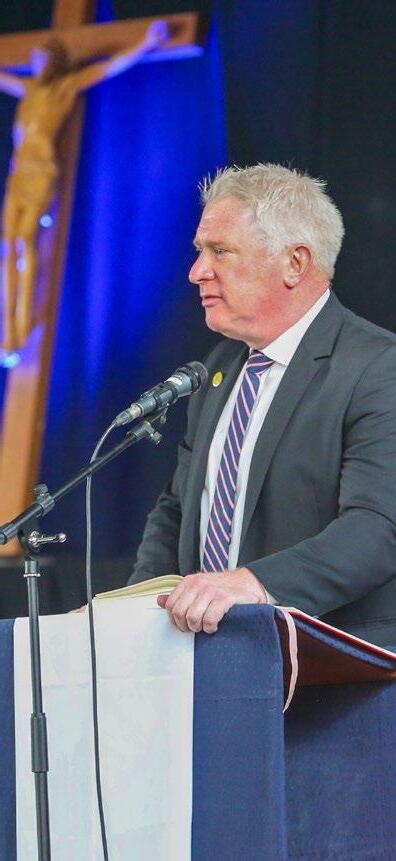
Why is practically no-one complaining about the RED, which becomes mandatory this September for all Catholic secondary schools?
Since the start of this school year, our RE departments have been busy implementing the RED, and some are already fully compliant. What is surprising is just how little complaint there has been amongst RE teachers. The RED is being imposed on all Catholic schools, and yet our RE teachers are largely compliant. In what follows the reasons for this high level of compliance will be outlined.
Perhaps it is helpful to outline why some level of non-compliance or objection to the centralised imposition of the RED might have been expected, particularly amongst RE teachers.
Firstly, the precursor of the RED was the 2012 Curriculum Directory for Religious Education (CDRE). This had been used to underpin the content of the RE programme in Catholic schools since 2012, and it would have been expected to remain in place for a far longer period. However, planning for the RED began in 2017, just five years after the CDRE came into force. Even in these times of rapid educational innovation, this haste in replacing the 2012 guidance is surprising, and one might have expected some discontent with this new development and curriculum change. In effect, RE teachers had only just gained their familiarity with the CDRE, and the prospect of implementing a new Directory ought, presumably, to have triggered concerns over both increased work and questions over why the Bishops and their agencies are changing the RE provision so soon.
Second, there has been in the recent past a high degree of tension over the RE curriculum in Catholic schools in England and Wales.
Over three decades ago, there was some anxiety over the RE programme “Weaving the Web.” This programme, consisting of eighteen units of work delivered over the first three years of secondary school, sought to explore how the Catholic Christian worldview linked with both common human experiences (such as Community, Story, and People) and various world religions. It was an ambitious programme that sought to establish links between the pupils life experience and common human and religious themes, with the intention of educating children about the relevance of Catholic beliefs and values. It was primarily geared towards ‘pre-evangelisation’ and fundamental catechesis. Through following a spiral curriculum—where common themes are regularly revisited from a fresh perspective—the plan was for students to become capable of accessing or making sense of the central themes in the Catholic Christian worldview, and thus receive their RE as catechesis.
However, “Weaving the Web” was dogged by a couple of issues. The first was a slowness in rolling out the textbook resources. For a number of years, only the first three volumes (Community, Story and People) were available. Thus, for half the year the programme was fully resourced, but for the second half schools had to plug the gap with their own resources. This perhaps fuelled concerns amongst some that there was insufficient content within “Weaving the Web.” In many respects, the concerns over the ‘Catholic’ content of this programme were bound up with a larger national debate that started in 1995 with the publication of Arthur’s provocative analysis, The Ebbing Tide. This volume was a sustained critique of the Bishops of England and Wales, who, according to Arthur, had allowed the Catholicity of Catholic schools to disappear—such that most schools
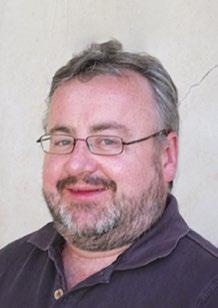
By Dr Sean Whittle
were Catholic in name only. One way of responding to Arthurs’s criticism was to look for ways of bolstering or reinforcing the formal ‘Catholic’ content in Religious Education. Almost inevitably, this led to a rejection of pre-evangelisation and a greater emphasis on more explicit catechesis and the teaching of Catholic doctrines. In response, two rival programmes developed to replace “Weaving the Web.” The first was a national programme known as ICONS, and the second was a programme centred around parts of the archdioceses of Westminster and Birmingham called the ‘Teachers’ Enterprise in Religious Education.’ The concerns over Religious Education rumbled on until the imposition of the Curriculum Directory for Religious Education, particularly the 2012 iteration. This contained an extensive listing of learning objectives and put far greater emphasis on what parts of the 1992 Catechism of the Catholic Church needed to be covered in RE in English and Welsh Catholic schools. In many respects, the 2012 CDRE effectively drew a line under the tensions and battles since the demise of “Weaving the Web.” In light of this, it is highly intriguing that the replacement of the 2012 CDRE has not reignited the debates amongst RE teachers and advocates of RE in Catholic schools.
Complaints over the heavy content? If RE teachers are raising complaints, it is criticism of the RED’s overabundance
of curriculum content that needs to be covered. In large part, the RED seeks to provide the widest range of content to students, so that as religiously literate people (through their deep and wide knowledge of Catholic beliefs) they can offer a defence or apology, if called upon to do so. The sheer amount of curriculum content specified by the RED reflects a desire for every student of a Catholic school to be sufficiently religiously literate to speak up in almost every situation that might arise over a lifetime. Students need to acquire enough religious literacy for life beyond school. This emphasis on curriculum content can be framed or justified in terms of being ‘knowledge rich.’ It might also hark back to the concerns raised with “Weaving the Web,” and an anxiety to ensure RE in Catholic schools is sufficiently challenging and full of worthwhile content. In a Catholic school, the 10% allocation of curriculum time to RE means there is space to cover a very wide amount of content. The guidance in the RED further fills this allocated curriculum time.
The problem with a content-heavy curriculum is that it can lead to an overly didactic pedagogy—and one where textbooks feature heavily. It is interesting to note in passing that there are already a range of textbooks written to help schools deliver the RED, published well before September 2025. There is perhaps
a more fundamental problem: when does a content-heavy (knowledgerich) curriculum become too dense? A related question is how much religious literacy is necessary to navigate life successfully? If the comparison is made with learning French or German, it is interesting to speculate that one could manage in France or Germany with relatively little literacy in these languages. It is not clear how much religious literacy is needed to navigate life successfully. The RED appears to operate on the assumption that a very significant level of religious literacy is needed. Presumably, this is because it seeks to produce skilled and sophisticated apologists capable of explaining, describing, analysing, and defending Catholic Christianity. It may well be that Catholic schools might offer high-level religious literacy as their unique proposition to parents and children—just as, in recent times, some schools were designated ‘language colleges’ or specialised in Maths and Science. However, having a unique offer does not by itself explain why being so highly religiously literate is a desirable or worthwhile educational goal.

At the very least, the implementation of the RED ought to trigger questions over how best to frame our philosophy or theory of Catholic education, and to ponder how important the RE part of the curriculum should be in a Catholic school.
In March 2025, a diverse cohort of 25 Catholic educational leaders from primary and secondary schools across England participated in a pilgrimage to Assisi, Italy. The pilgrimage, organised by EducareM, was guided by Sister Judith Russi SSMN, Director of EducareM, and Canon Jonathan Vesey, Vicar General of the Archdiocese of Birmingham. This professional development initiative was uniquely positioned within the Vatican's Jubilee Year of Hope, providing participants with a framework for connecting historical, spiritual pedagogy with contemporary educational challenges.
The pilgrimage systematically guided participants through significant historical sites while incorporating structured reflective practices, collaborative dialogue sessions, and liturgical experiences. The five-day programme was designed as embodied professional development, allowing educational leaders to experience the transformative potential of place-based spiritual formation. Participants engaged with four primary spiritual exemplars through site visits and scholarly discussions:
St. Rufino's Cathedral
At the Cathedral of San Rufino, participants explored the historical significance of Assisi's first bishop and patron saint. Educational leaders listened to Canon Jonathan detailing St. Rufino's third-century evangelisation methodologies. Particular emphasis was placed on the cathedral's baptismal font, where both St. Francis and St. Clare were baptised, prompting discussions about foundational faith formation in educational settings. The architectural pedagogy of the cathedral itself served as a case study for how physical environments can communicate theological concepts in educational spaces.
Franciscan Sites
Multiple Franciscan locations provided rich material for professional reflection, including:
• The Basilica of St. Francis: Pilgrims analysed Giotto's frescoes depicting Francis's life, identifying pedagogical principles embedded within the visual narrative sequence. Educational leaders examined how these medieval teaching tools might inform contemporary approaches to visual literacy and values education.
• San Damiano Cross: The cross that spoke to Francis, instructing him to "rebuild my church", sparked extensive discussion about transformational leadership and institutional renewal. Leaders reflected on parallels between Francis's initial literal interpretation (rebuilding physical structures) and his eventual understanding (revitalising the spiritual community)—a progression that offers insights for educational change management.
• Porziuncola: Within the Basilica of Santa Maria degli Angeli, this small chapel where Francis founded the Franciscan order prompted examination of how mission-centred spaces influence organisational culture and identity formation.
St. Clare's Basilica
The pilgrimage's engagement with St. Clare's legacy focused on her educational contributions through the Poor Clares. Educational leaders discussed Clare's adaptations of Franciscan principles for different contexts, offering a historical model for contextual leadership. Her relics and the San Damiano crucifix she protected provided tangible connections to her educational philosophy, which was centred on contemplation and action.
The contemporary example of Blessed Carlo Acutis provided a critical bridge between historical and modern educational approaches. At the Sanctuary of the Renunciation, which houses Carlo's tomb, participants reflected on his systematic documentation of Eucharistic miracles and his technological evangelisation methods. Educational
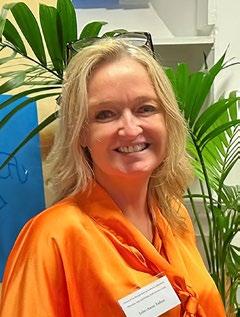
By Julie-Anne Tallon
leaders discussed how Carlo, as a teenager, developed digital catechetical resources, offering a contemporary model for technology integration in faith formation. This site prompted substantial discussion about digital pedagogy and youth engagement strategies.
Throughout the pilgrimage, participants systematically connected their observations to Pope Francis's Jubilee Year of Hope encyclical themes, including:
• Ecological Stewardship: Francis's ‘Canticle of the Creatures’
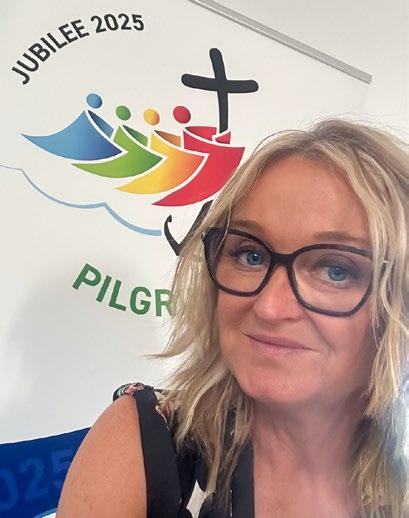
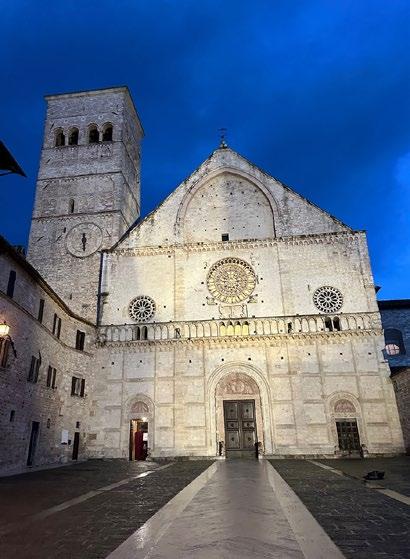
was analysed as a foundational text for environmental education, with participants discussing cross-curricular applications.
• Inclusive Community: Clare's radical hospitality principles were reflected upon for applications to contemporary diversity and inclusion policies in Catholic education.
• Technological Discernment: Carlo Acutis's example prompted discussion of digital citizenship formation and ethical technology use in educational settings.
This structured pilgrimage exemplified how historical spiritual traditions can be systematically examined
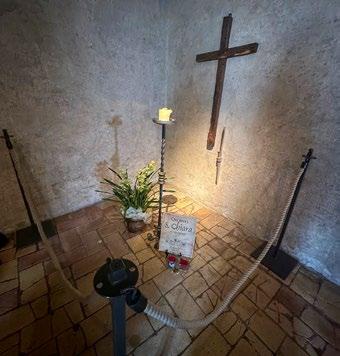
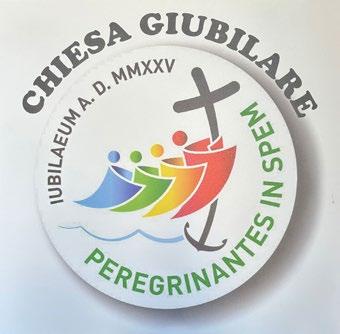
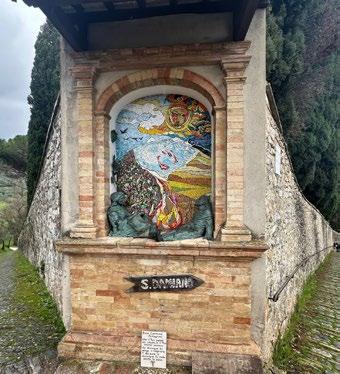
for contemporary educational applications. By engaging with Assisi's rich spiritual heritage during the Jubilee Year of Hope, these educational leaders developed evidence-based approaches to integrated spiritual and academic leadership. Ongoing spiritual formation will continue through EducareM programmes with attending schools. To find out more about EducareM formation opportunities visit: educarem.org.uk
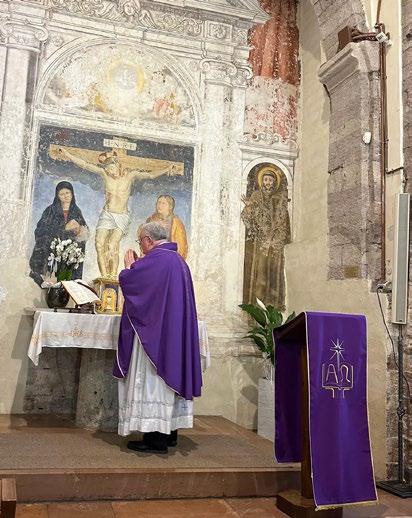
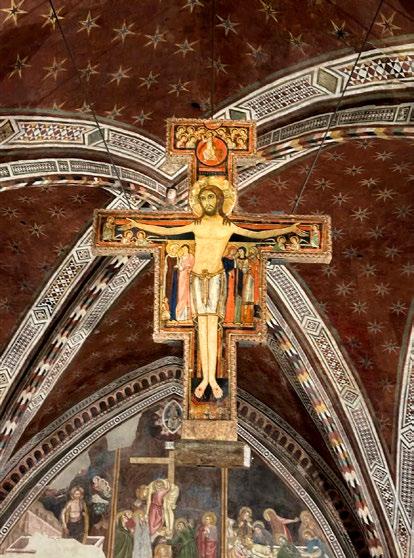
Catholic schools in the UK are constantly evolving, taking on the mantle of innovators in the realm of education. They are not just about imparting knowledge but are also dedicated to inspiring creative change and addressing the challenges faced by society. By fostering an environment that encourages critical thinking, creativity, innovation and problem-solving, Catholic schools equip their students to become the leader’s society needs for today and tomorrow, with the skills necessary to navigate and influence the modern world.
At the heart of Catholic education lies the person of Jesus Christ, his teachings and witness. Whilst Catholic Schools strive to profess a Christ centred approach to learning, it can sometimes be challenging for teachers to know what exactly this means. How does one understand applying the Gospel in such a way that it has a profound relevance to life today?
EducareM has developed a methodology for just this challenge entitled, Building the Kingdom enabling both teachers and pupils to marinate teaching and learning through the key Gospel challenges expressed through Catholic Social Teaching. Students are taught to see the world through the lens of its radical major themes. This approach not only enriches their academic experience but also shapes them into conscientious citizens who are committed to the common good. By placing social teaching at the heart of pupils' learning, Catholic schools ensure that values such as the dignity of the human person, solidarity, dignity of work, option for the poor, rights and responsibilities and stewardship remain central to their educational mission.
Headteachers in Catholic schools play a crucial role in shaping the leaders of today and tomorrow. Their leadership
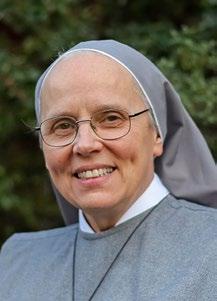
goes beyond administrative duties; they are called to be mentors, role models, and visionaries. By leading with integrity and faith and a dynamic commitment to the Gospel and Catholic Social Teaching, they inspire both their staff and students in the pursuit of excellence and service. The emphasis on leadership formation ensures that the next generation of leaders is wellequipped to carry forward the mission of Catholic education. This formation process is essential for all in a leadership position and is now actively encouraged by the Bishops of England and Wales. To help met this request from the Bishops, EducareM has pioneered two major programmes for all in leadership positions in school or Boards of directors and CMAC teams, the “Christ The Teacher” programme for Heads and directors and the “Tabor” programme for Deputy heads, Assistant heads and experienced middle leaders. These programmes focus on the individual’s vocation as a leader and the radical mission of the Gospel and Catholic Social teaching for today and tomorrow.
Formation for young people to be active leaders and proponents of the Gospel is critical. This involves nurturing a deep understanding of faith and encouraging students to live out their beliefs through action. Schools are amazing in their fund-raising endeavours, often raising thousands of pounds for charity. However, we need to ensure that we address the causes of injustice and poverty including strategies for change and prevention. Education and action together help pupils to engage at a deeper level in social justice initiatives, community service, and oracy training for advocacy, as they learn to be Gospel activists striving to make a positive impact in the world.
Over the past few decades, we have heard the call to a more radical form of Catholic education from Pope John Paul

II who emphasized the transformative power of Catholic education. He often spoke about the importance of nurturing the human spirit and fostering a commitment to truth and moral integrity. So too Pope Benedict XVI on Mission-Driven Schools calling for Catholic schools to create environments where students can encounter the living Christ and experience the transformative power of the Gospel. Pope Francis continues this challenge urging Catholic schools to be inclusive, compassionate, and socially engaged. He challenges educators to go beyond academic excellence to include the formation of character and the promotion of social justice. For Pope Francis, missiondriven schools are those that prioritize the marginalized, advocate for the poor, and work towards building a more just and equitable society.
Leading a mission-driven school is essential if Catholic education is to remain faithful to its core mission in these rapidly changing times. This involves embracing innovation, fostering collaboration, and prioritizing the holistic development of students. By integrating Catholic social teaching into all aspects of education, schools can ensure that students are not only academically prepared but also spiritually and morally grounded. Headteachers and educators must continue to lead with vision and purpose, inspiring the next generation to become leaders who are committed to faith, service, and
justice. By preparing young people to be Gospel activists, Catholic education can contribute to the transformation of society, making it more compassionate, just, and inclusive.
Despite the noble mission of Catholic education, schools today are facing significant financial challenges. Rising costs, funding shortfalls, and economic uncertainties are among the key issues that schools must navigate. These financial pressures can threaten the ability of schools to maintain their mission-driven focus and provide quality Catholic education. It is crucial to understand that finance must serve mission and not the other way around. Schools must prioritise mission and make financial decisions that support their core values and objectives for today and the future. This is very challenging for those tasked with keeping the school financially viable, but it is a central part in keeping the school on mission.
To ensure the mission and future of Catholic schools much effort is going into the restructuring of Catholic Multi-Academy Trusts (CMATS) across the country. These efforts can be a powerful witness to the call for transformation and change within the educational sector and society. By restructuring and consolidating resources, CMATS can enhance their operational efficiency and strengthen their capacity to deliver an authentic, relevant, quality Catholic education. This process not only helps to address
financial challenges but also reinforces the commitment to providing missiondriven education which has the potential to impact significantly on society and the common good today and in the future.
Formation for mission must be a top priority. Some dioceses have taken this urgent step of ensuring that Boards of Directors, CEOs, CFOs, Governors, and Headteachers are supported as a priority for ongoing formation. If the leaders are on mission, the rest will follow. Mission drift is an easy trap to fall into. By instilling a robust sense of purpose and direction among the leadership, Catholic education systems can safeguard against such drift and maintain their commitment to their core values and objectives. This focus on formation ensures that the mission remains at the heart of all decisions and actions, fostering a cohesive and dedicated community that can effectively navigate the challenges and opportunities ahead in building a fairer and just society.
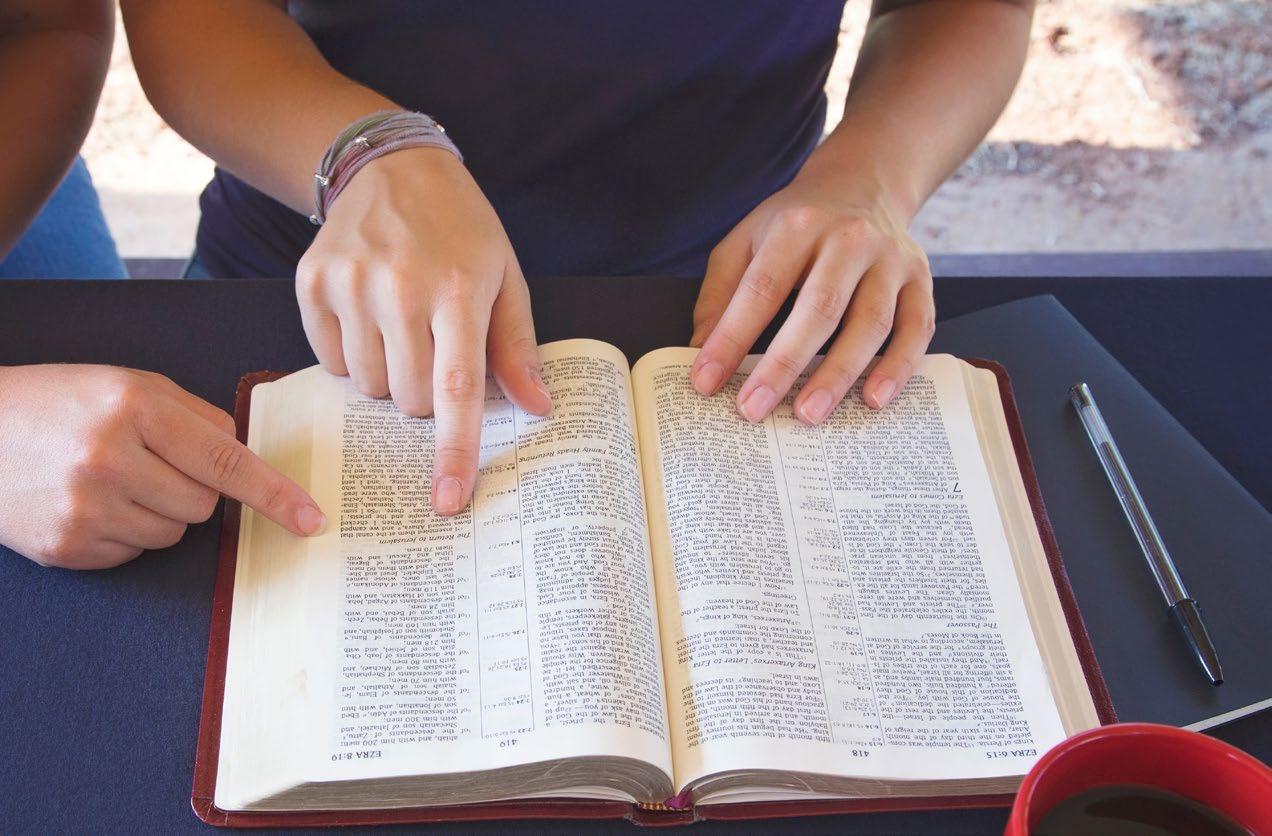
Pope Francis reminds us that as we look to the future, Catholic education has a vital role to play in shaping the minds, hearts and hands of young people. By remaining steadfast in its mission and embracing the opportunities for growth and innovation, Catholic education in the UK can continue to be a powerful force for good in the world.
Introduction
In November 2024, the Confederation of School Trusts (CST), the Church of England’s National Society for Education and the Catholic Education Service (CES) published a joint ‘vision’ document, Flourishing Together. It set out ‘ten seeds’ necessary for the ecology of human growth within education, rooted within ‘a collective and hope-filled visionthat the best unifying concept around which to build the education system for the coming decades is that of flourishing – flourishing children and flourishing adults in flourishing schools’ In the document, this challenge and call to ‘flourish’ was explored through the five realms of flourishing identified by Swaner and Wolfe : Purpose; Relationships; Learning; Resources and Wellbeing.
Simultaneously, the CES published a sister document Called to Flourish in Faith and Hope, which explored this understanding more fully from a Catholic educational perspective. Mindful of the call for Catholic education ‘to witness to alternative values and demonstrate the possibility of a different lifestyle’ , it sought to understand what it is to flourish in a Catholic educational context, within five comparable but distinct realms. These are: Mission; Communion; Formation; Gifts and Fruitfulness.
Understanding ‘Flourishing’
So, what does it mean ‘to flourish’ in a Catholic school? It is an understanding that we are all made in the image and likeness of God, gifted with an inherent dignity and graced with a transcendent purpose to realise God’s love on earth. In the daily life of a school, this dignity and purpose is manifest in a pedagogical approach which seeks to engender a holistic formation of the person so we may realise life in all its fullness in mind, body and spirit.
‘An all-round education seeks to develop every aspect of the individual: social, intellectual, emotional, moral and spiritual. For there is ecology of human growth which means that if any one of these elements is overlooked all others suffer’.
Therefore, a Catholic education offers a ‘sound academic education, within a caring community, underpinned with a coherent ideology’ and it is this ideology that defines, directs and informs every aspect of the educational experience. In so doing, it constructs and shapes an ethos which identifies and makes tangible the way in which this ideology can be inhabited and shared. This is realised through behaviours, what we do, and operations, how we do it, both being explicitly informed by why we do it. Therefore a flourishing school is one in which both ‘behaviours’ and ’operations’ , the personal and the commercial ‘are unified and exemplified in ‘a moral enterprise’. This is identified in Formation in Virtues, providing ‘opportunities not only to ‘do the good’, but educating in virtues so that’ a disposition towards the good is both ‘firm’ and ‘habitual’. Habits make us who we are. The educational challenge is to find ways that this enterprise can be imaginatively and engagingly undertaken in our schools’.
In this article I shall briefly outline the content of Called to Flourish in Faith and Hope and how the concept of a flourishing school is explored through each of the ‘five realms’ of Mission; Communion; Formation; Gifts and Fruitfulness.
The mission of the Church and by virtue of that, the mission of Catholic education is to form individuals so that they may best respond to the call to human fulfilment through relationship with God. Canon Law acknowledges this, asking that Catholic schools ‘pay regard to the whole person, so that all may attain their eternal destiny and at the same time promote the common good of society’. This is an empowering educational narrative, an unequivocal call to our schools to be places of human flourishing in which we will realise the fullness of our potential in all its dimensions: physical, mental, spiritual and relational.
St John Henry Newman recognises this in the prayer, The Mission of My Life, in which he explores how each one of us is called to fulfil a unique vocation in our own time and place.
Our schools, are therefore, called to be places in which this unique vocation can be discerned and realised and by truly committing to this relationship of trust, we are brought to an understanding of our giftedness and our call to flourishing. Newman’s prayer acknowledges that we may not see or understand the full fruit of this flourishing in the here and now, but we will do in eternity. This realises the transcendent nature of Catholic education whose mission is not simply to prepare us for a flourishing life in this world but also in the next: ‘only in time and beyond our own death will we see the way God is using us for his plans and providence. The totality of our lives is greater than the sum of its parts’.
This mission extends to all who participate in the life of our schools. ‘Therefore, we are called to be ‘courageous’ and show ‘innovative fidelity’ to our distinct pedagogical vision, through knowing it, bearing witness to and dialoguing with diversity. This dialogue is an essential component of our contemporary mission in education. In a broader sense, it contributes to and ‘fosters a peaceful society’, but in a personal sense, it creates ‘the conditions for a person to develop a gift for searching. This may bring some to the ‘threshold of faith’ and others to an ‘experience of faith’ but it invites all to a deepening experience, a flourishing which synthesises faith and life, forming all to a growing awareness and an understanding of our place in the world.
This is, perhaps, more readily described, within a Catholic context, as ‘Formation’: “a continuous process of personal maturation and conformity to Christ, according to the will of the Father, under the guidance of the Holy Spirit”. In the context of the school, formation, therefore, is an educational intent that asks us to accompany and nurture human growth in consciousness, attitudes, knowledge and beliefs so that all may live a flourishing life according to their vocation.
The Catholic school is an ideal locus for such formation, as ‘the development of the inner character rather than mere academic achievement, is the leitmotif of its educational vision’. And this imperative to formation ‘is not the privilege of a few, but a right and duty of all’. Not only are teachers called to create learning environments
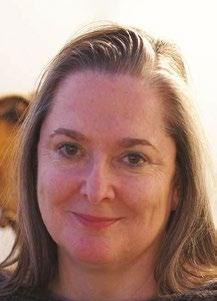
By Dr Maureen Glakin
Dr Maureen Glackin is a respected academic and leader in education, currently serving as the Director of Religious Education at the Catholic Education Service (CES).
that provide ‘plentiful opportunities…[for] profound learning’ but they are also invited to be formed by this life-enriching pedagogy. Indeed, Christifideles Laici calls this one of the ‘convictions’ of formation: ‘…one cannot offer a true and effective formation to others if the individual has not taken on or developed a personal responsibility for formation: this, in fact, is essentially a "formation of self". The other ‘conviction of formation’ is the cyclical and progressive nature of this process, in that ‘the more we are formed and the more we feel the need to pursue and deepen our formation, still more will we be formed and be rendered capable of forming others’.
In this way, Catholic education invites us to participate in a comprehensive formation process that develops the whole person, integrating faith with cultural and moral education, and fostering a community of learning that reflects the teachings of Christ.
‘All schools seek to achieve this flourishing within a community, ‘characterised by a sense of belonging…within a creative and innovative pedagogical vision’ , for Catholic schools, this ‘communion’ is also realised within a sacramental reality. Indeed, it may be argued that it is most fully realised when the school community celebrates together sacramentally: ‘The Eucharist both perfectly signifies and wonderfully effects that sharing in God’s life and unity of God’s people by which the Church exists’. Given the rich diversity of our schools, this may seem contrary, but the presence and active participation of the whole school community in such celebrations draws it into communion, reinforcing its spiritual unity through its very expression. In this way, the sacramental communion becomes a lived communion: ‘We cannot share the eucharistic bread without sharing our daily bread as well’ Therefore, ‘communion’ epitomises the very nature of a Catholic school, secularly and spiritually, as an environment where pupils are nurtured in faith and moral understanding as relational beings.
The Religious Education Directory reminds us that ‘[c]onsonant with the ecclesiology outlined in Lumen Gentium, the school is not simply an institution, a place where the mind is developed and formed, but a community, suffused with ‘a special atmosphere animated by the Gospel spirit of freedom and charity’. This freedom is understood through the acquisition of knowledge, knowledge of self, knowledge of the world, knowledge of life and knowledge of faith. This charity is realised in communion with the world, in the way pupils and staff learn to exercise their freedom responsibly and for the common good.
A flourishing school is one that recognises the gifts of its members and provides opportunities to allow them to flourish for the common good of all. Just as we are assured that ‘there is a variety of gifts’, a school community relies on individual personal and professional gifts and therefore the gifts of its community to realise its vision. These gifts take many forms, echoing the ‘varied hierarchic and charismatic
gifts’ bestowed by the Holy Spirit and whether ‘extraordinary or simple and humble…[they] are graces of the Holy Spirit which directly or indirectly benefit the Church’ and in our context, the school community.
It is this sharing of ‘gifts that differ’ which contributes to a stewardship of the whole educational endeavour, with each individual gift, enhanced and reliant on the gift of the other. The prophet creating the vision; the server building the vision; the teacher communicating the vision; the exhorter, encouraging all to participate in the vision; the contributor, giving time, talent, finance to resource the vision; the leader, organising, directing, administrating the vision; the one who shows mercy, ensuring the vision is realised with compassion and care. Of course, there are challenges and difficulties in this, but these will be navigated using the gifts of the community to inform decision-making that supports and safeguards a culture of flourishing, in which we engage responsibly with the world and with one another.
Fruitfulness is a call to cultivate life to its fullest, an invitation to an inner and outward flourishing for the development of society, spiritually, morally and culturally. The fruits of the Holy Spirit, as enumerated in Galatians 5:22-23, include love, joy, peace, patience, kindness, goodness, faithfulness, gentleness, and selfcontrol. Such virtues are manifestations of our gifts and are seen as the hallmarks of a life welllived, embodying the love of Christ in action. Pope Francis suggests that it is a good spiritual exercise to read this list ‘and take a look at our own behaviour to see if it corresponds, if our life is truly in accordance with the Holy Spirit, if it bears these fruits’.
Exercising such a positive approach to life can only serve to make us mindful of our own wellbeing and the need for time and space in our lives, in our schools to reflect, pray, recharge and refresh. Pope Francis reminds us that we cannot ‘forget the original fruitfulness of love nourished by prayer which brings peace and joyful witness’.
We are, therefore, asked to nurture fruitfulness in ourselves so that we can extend it in loving service to our schools. in the hope it will bear fruit for us all.
Conclusion
Participation in the mission of the Church in education is an unapologetic call to flourishing. It is a call to a fullness of life, a nurturing into being fully alive in mind, body and spirit through a ‘process of relational dialogue, interacting in a constructive way, exercising tolerance, understanding different points of view and creating trust in an atmosphere of authentic harmony. Such a school is truly an educational community, a place of differences living together in harmony’. And such a school is a flourishing school.
Endnotes
CST, National society for Education, CES, 2024Flourishing Together: A collective vision for the education system, p1
See National Society for Education2023,Our
hope for a Flourishing Schools System and, Swaner, L. & Wolfe, A., 2021Fourishing together – A Christian Vision for Flourishing Children, Flourishing Educators and Flourishing Schools, Wm. B. Eerdmans Publishing, Michigan
iiiSullivan, J. Catholic Schools in Contention, Lindisfarne Books, Dublin, 2000, p14.
ivJohn, 10:10.
v Pope St. John Paul II, Address to the new Ambassador of the Republic of Malawi to the Holy See, 14 December 2000.
viZipfel, R. ‘Who do we serve and what do we offer?’ in McLaughlin T. O’Keefe, B, (eds) The Contemporary Catholic School, Context, Identity and Mission, The Falmer Press, London, 1996, p211.
Department of Catholic Education and Formation, CBCEW, 2020, Formation in virtues: Educating the Whole Person, London p3.
The Identity of the Catholic School for a Culture of Dialogue, Congregation for Catholic Education, 2022, n10.
Canon 795, from Gravisimum Educationis, 1965, n.1
St John Henry Newman, ‘Meditations and Devotions’ ,"Meditations on Christian Doctrine," "Hope in God-Creator", March 7, 1848
Swann, Fr B. November 15th 2019, https:// www.wordonfire.org/articles/unpacking-one-ofnewmans-gems/
The Identity of the Catholic School for a Culture of Dialogue, Congregation for Catholic Education, 2022, n27.
Ibid. n28.
Pope St John Paul II, Christifideles Laici, 1988, n57.
Formation in Virtues: Educating the Whole Person, Department of Catholic Education and Formation, Bishops’ Conference of England and Wales, London, April 2020, p3.
Pope St John Paul II, Christifideles Laici, 1988, n63.
The Identity of the Catholic School for a Culture of Dialogue, Congregation for Catholic Education, 2022, n29.
Pope St John Paul II, Christifideles Laici, 1988, n63.
Flourishing Together, Confederation of School Trusts, National Society for Education, Catholic Education Service, 2024, p4.
Eucharisticum Mysterium, 1967, n6; Lumen Gentium, n11.
Kasper, W. Theology and the Church, SCM Press, London, 1989, p191.
To know you more clearly: The Religious Education Directory, CBCEW, 2023, p2. Catechism of the Catholic Church, n768.
Ibid. n799.
Pope Francis, 2021, General Audience, Rome 27th October
Male and Female He Created Them, Congregation for Catholic Education, 2019, n40. St John Henry Newman, Flourishing Together and Called to Flourish in Faith and Hope
The Society of St Vincent de Paul in Glasgow initiated the Frederic Ozanam Scholarship several years ago to help pupils of Catholic secondary schools in the Glasgow archdiocese with the cost of further education at university.
Priority was given to pupils who, because of financial hardship, would not be likely to embark on a university education.
The scheme, which was piloted in four schools, awards the sum of £1,500 to each successful applicant, to be paid in each year of their chosen degree course. The pilot was deemed successful and was extended to 12 schools.
To be eligible, applicants must intend to study at one of the three universities in Glasgow (University of Glasgow, University of Strathclyde, Glasgow Caledonian University); fulfil the criteria of the Student Agency Award Scotland (SAAS); not be in receipt of any other scholarships for their university education; and have the written approval of authorised representatives of their school.
The assessment criteria are based on the financial situation of the applicant’s household; academic achievement; work experience; extra-curricular activities and achievements.
In total 16 awards have been made since the scheme started and eight more are in place for the current academic year.
Seven students from previous years have already graduated. Many praised the scholarship, giving testimony to how it enabled them to successfully complete their degrees.
One recipient, Alexandra, said: ‘This scholarship has been incredibly helpful
during my university experience. Especially when starting my first year, I needed to buy things like new laptop for my course and I couldn’t have done so without this.
‘I am forever grateful for this help.”
Calum, who also won an early scholarship said: ‘In my first year of university the scholarship allowed me buy a laptop that I could use in the lectures and tutorials. It became crucial in the next two years when I had to study from home.
‘I am extremely grateful for the scholarship as it has benefited my studies greatly.
Oluwatosin said: ‘Being a student nurse, it has helped me get resources and equipment to equip me for the world of work and during nursing school also. I am forever grateful for this wonderful opportunity’.
The scholarship has now been extended to all 18 Catholic secondary schools in the archdiocese, and applications are currently being considered.
Jim O’Hagan from Glasgow SVdeP said: ‘It is gratifying to know that the Frederic Ozanam Scholarship has enabled young people to achieve the success of a university education that might otherwise have eluded them as a result of circumstances outwith their control.
‘It is hoped that it will continue to do so into the future and, who knows, may extend throughout Scotland in due course’.
Invitations to schools, requesting applications from pupils who meet the eligibility criteria are sent out in August. The deadline for completed applications is the last Friday in December.

By Jim O’Hagan

JOHN NISH, PRESIDENT OF THE CATHOLIC ASSOCIATION OF TEACHERS, SCHOOLS AND COLLEGES
As we embrace the Spring Term of 2024, I am delighted to share the latest developments and reflections from the Catholic Association of Teachers, Schools and Colleges (CATSC). This term has been one of growth, collaboration, and renewed commitment to our mission of supporting Catholic education.
A key highlight of the past term was our participation in the World Union of Catholic Teachers (WUCT) Council in Chile this past November. The visit provided a valuable opportunity to engage with international colleagues, sharing insights on the global challenges and opportunities faced by Catholic educators. Discussions focused on faith formation, professional development, and the role of Catholic education in an ever-secularising world. It was inspiring to witness the shared commitment to upholding the mission of Catholic education worldwide.
We are pleased to report that membership in CATSC has seen an encouraging increase in the 2024-2025 period. This growth reflects the ongoing need for a strong network of Catholic educators who can support each other in their professional and spiritual journeys. The association continues to provide valuable resources, professional development opportunities, and a collective voice for Catholic teachers.
Collaboration with EducareM and the 2026 Joint Conference
Our collaboration with EducareM has been a significant step forward in strengthening Catholic education. We are currently working together to organise a joint conference scheduled for 5 March 2026 at Coombe Abbey near Coventry. We are honoured that Cardinal Pierbattista Pizzaballa, OFM, the Latin Patriarch of Jerusalem, and Bishop Michael Brehl, C.S.s.R, Bishop of Pembroke, Canada have been invited
as keynote speakers. Their presence will provide deep theological and pastoral insight, enriching our discussions on the future of Catholic education. We look forward to an inspiring and thoughtprovoking event that will unite educators in faith and purpose.
As part of our ongoing commitment to understanding and addressing the concerns of Catholic educators, we conducted a survey involving approximately 800 responses from teachers and support staff within St Ralph Sherwin CMAT, which educates 8,000 children across 25 schools. The survey has highlighted several key challenges:
1. Integration of Catholic Teachings into the Curriculum
• Teachers face difficulties embedding Catholic values into daily lessons while maintaining academic rigour. Greater access to faith-based resources and training is essential.
2. Maintaining Catholic Identity in a Secular Society
• There is a growing challenge in preserving the Catholic ethos of schools amidst societal pressures, necessitating stronger formation for teachers and school leaders.
3. Addressing Diverse Student Needs
• With increasing diversity in student backgrounds, Catholic educators must balance inclusivity with faith-based teachings, ensuring all students feel valued while upholding Gospel values.
4. Professional Development and Support
• Many teachers express a need for professional development that integrates both pedagogical excellence and Catholic identity. CATSC remains committed to advocating for more tailored training opportunities.
5. Engagement with Parents and the Wider Community
• Stronger partnerships between schools and families are needed to reinforce Catholic identity at home and within the community.
6. Emotional and Spiritual Wellbeing
• The rise in mental health challenges among students has placed additional responsibilities on teachers. Support structures and faith-based wellbeing programmes must be prioritised.
7. Navigating Policy Changes
• Shifts in government policies and funding continue to pose obstacles to Catholic education. Advocacy efforts are crucial to ensure Catholic schools retain their distinct mission.
8. Promoting Catholic Social Teaching
• Educators strive to instil social justice principles in students, encouraging them to live out Catholic social teaching in practical ways within society.
As we move forward, CATSC remains steadfast in supporting Catholic educators through professional development, collaboration, and advocacy. We encourage all members to actively participate in shaping the future of Catholic education, ensuring that our schools remain places of faith, excellence, and service.
Thank you for your continued dedication to the mission of Catholic education. May this term be one of renewal and inspiration for all our members.

John Nish President, Catholic Association of Teachers, Schools and Colleges
The Catholic Association of Teachers, Schools and Colleges (CATSC) and EducareM, are delighted to announce a groundbreaking partnership aimed at advancing the mission of the Catholic Church in education – the transformation of the person for the transformation of society. This collaborative initiative is set to harness the strengths of each organisation, ensuring a holistic and impactful approach to Catholic education across England and Wales and beyond.
The partnership embodies a shared vision rooted in the values of the Catholic Church, focusing on the integral development of individuals. The collective efforts will target various aspects of educational life, including teacher formation, school leadership, and community engagement, all with the aim of nurturing compassionate, knowledgeable, and socially responsible individuals.
John Nish, National President of CATSC, expressed his enthusiasm about the partnership: “We are thrilled to unite with EducareM in this transformative journey. Together, we aim to create educational environments that not only impart knowledge but also foster moral and spiritual growth, preparing our students to be agents of positive change in society, modelled on Christ the Teacher.”
Sister Judith Russi, Director of EducareM, highlighted the synergy of the collaboration: “By aligning our expertise and resources, we can significantly enhance the quality of Catholic education. Our focus on innovative and inclusive educational practices will equip students and educators with the tools they need to contribute to a just and compassionate world.” The collaboration will encompass a series of initiatives, including:
1. A launch national Catholic Day Conference of Education on Thursday 5 March 2026 co-facilitated by His Lordship Bishop Micheal Brehl, Diocese of Pembroke, Ontario and other prominent international Catholic speakers. The conference will be held at Coombe Abbey with the option of overnight accommodation on 4 March 2026. The theme of the conference will
be: Catholic Schools responding to the challenges of today.
2. Professional Development for Educators: Comprehensive training programs and workshops for teachers and school leaders, focusing on faith integration, pedagogical innovation, and leadership in Catholic education.
3. Research and Development: Joint research projects aimed at exploring new methodologies and best practices in Catholic education, with an emphasis on inclusivity, social justice, and community engagement.
4. Community Outreach and Support: Development of community-based programs that engage students, families, and local communities in service-oriented projects, promoting the Catholic values of solidarity and the common good.
5. Curriculum Enhancement: Creation of resources and materials that reflect Catholic teachings and values, providing leaders, teachers and ultimately students with a rich and relevant educational experience.
The partnership will leverage the extensive network and resources of each organisation. CATSC brings decades of experience in supporting Catholic educators; EducareM contributes innovative educational models and a commitment to social justice. This collaboration is a significant step toward fulfilling the Catholic Church’s mission in education: to transform individuals who will, in turn, transform society. By working together, CATSC and EducareM aim to create a legacy of empowered individuals ready to contribute to a more just, compassionate, and vibrant world.
For more information about this partnership and upcoming initiatives, please visit www.catsc.org and www. educarem.org.uk.
About CATSC:
The Catholic Association of Teachers, Schools and Colleges (CATSC) is a leading organisation dedicated to supporting Catholic education professionals serving in schools and colleges in England and Wales. CATSC provides materials, training, and advocacy to promote excellence in Catholic leadership, teaching and learning.
About EducareM:
EducareM is an innovative educational organization committed to fostering social justice and community engagement
through education. EducareM focuses on developing inclusive and transformative educational practices that empower individuals and communities.
For further inquiries, please contact: Catholic Association of Teachers, Schools and Colleges (CATSC) General Secretary St Mary’s University, Twickenham E: caroline.healy@stmarys.ac.uk EducareM E: admin@educarem.org.uk
Theme: Mission and Identity in Catholic Education in the 21st Century: theory and practice
DATE: Mon. 16th- Wed. 18th June 2025 (in St Mary’s 175th Anniversary Year)
Confirmed speakers include:
Archbishop John Sherrington
Professor James Arthur (Harvard University)
Josephine Shamwana-Lungu (Diocese of Lusaka)
Rev. Professor Rodel Aligan, OP (University of Santo Tomas, Manila)
Professor Anthony McClaran (Vice Chancellor St Mary’s University)
Professor John Lydon (Professor of Catholic Education St Mary’s University)
The Colloquium
In St Mary’s University’s special 175th anniversary year, the Steering Group is proud to host the second international Global Researchers Advancing Catholic Education (GRACE) Colloquium, continuing St Mary’s tradition of being the leading university in the UK with a Catholic identity. You are invited to submit papers on contemporary Catholic education on the theme of ‘Mission and Identity in Catholic in the 21st Century: theory and practice’.
Catholic education has a global span, with the power to dynamically influence students, create futures and provide enrichment in the wider community and society. The discipline of Catholic
education in the past 20 years has emerged as an ever-developing interdisciplinary research field, drawing from education, theology, religion, philosophy, ethics, sociology and history. Catholic education researchers have made significant theoretical contributions to the field, especially in the areas of spiritual capital; Catholic school leadership formation; the maintenance of distinctive religious charisms among lay headteachers, religious education and achieving a balance between academic standards and a holistic education.
The landscape of Catholic education continues to experience significant developments and challenges. The notion of the perennial aspects of Catholic education, in constant dialogue with the transitional educational landscape, will be welcomed. The extent to which Catholic school teachers, leaders and governors embrace the challenge to embed core Catholic education principles and maintain their integral mission, while acknowledging a range of factors challenging the holistic perspective canonized in Catholic tradition, will be sought for this colloquium.
Building on the first GRACE Colloquium 2024 held at the University of Notre Dame, Fremantle, communities of practice will feature prominently in the GRACE Colloquium 2025.
Researchers and practitioners are invited, therefore, to submit abstracts addressing this topic. The Steering Group welcomes abstracts from both researchers and those involved in the daily reality of leading schools and education institutes ‘on the ground’.
Global Researchers Advancing Catholic Education (G.R.A.C.E) is an international research-based partnership between scholars in Australian Catholic University; Boston College, United States; University of Glasgow, Scotland; Mary Immaculate College, Limerick; University of Notre Dame Fremantle, Australia; St Mary’s University in Twickenham, London., Edith Cowan University, Australia. As an emerging community of practice (Wenger, 2000), G.R.A.C.E. provides an original opportunity for scholars of Catholic education, theology, philosophy, history and social sciences in our respective countries to affirm, study, collaborate and respond meaningfully to challenges we face in the field.
Toward this end, our initiative:
• Seeks a deeper study of ecclesiology and Christian anthropology and its significance for Catholic education
• Pursues new theories of Catholic education based on empirical research
• Strengthens a global argument for the importance of faith-based schools in a plural society
• Attunes educators’ abilities to notice, engage, and celebrate the presence of God’s grace in the world
This partnership promotes research and learning to develop the head, heart, and hands of Catholic education. The colloquium will include a combination of traditional papers and roundtable discussions.
Registration is Currently Open Here: https://www.stmarys.ac.uk/events/ 2025/g.r.a.c.e-international-colloquium
Need further information? please contact conference organisers: Professor John Lydon: john.lydon@stmarys.ac.uk and/or Dr Caroline Healy: caroline.healy@stmarys.ac.uk
Special Issue
A special issue of the international peer-reviewed journal, International Studies in Catholic Education, the first ever international and interdisciplinary journal devoted to the systematic study of Catholic education, edited by Professor John Lydon in collaboration with the GRACE Steering Committee, is being planned as a result of this colloquium. Those who wish to have their paper considered for this special issue will be invited to submit their papers by the end of December 2025.
Many congratulations to Kerry Macfarlane, who recently successfully defended her doctoral PhD research at St Mary’s University on the topic of Catholic Character Education in Primary Education, was supervised by Professor John Lydon and Dr Caroline Healy, St Mary’s University, Twickenham. Kerry is an Assistant Headteacher and Year 6 Teacher at Corpus Christi Primary School, Boscombe. She was awarded an All Hallows Trust Scholarship, Dublin, to facilitate this research. The scholarship provided her with an opportunity to
engage with other researchers within the Global Researchers Advancing Catholic Education (GRACE) community of practice. It has also provided a future platform to share the outcomes of the research in order to make a positive contribution to character education in Catholic primary schools both in the UK and internationally.
The research study was an exploration of the constitutive elements of character education and their contribution to the formation of pupils in Catholic primary schools in England. The key research question is: To what extent, and in what ways, does Catholic character education contribute to the formation of pupils in primary schools in England? This framed the intent of the empirical outcomes and the focus on how schools, through both implicit and explicit approaches to character education, promoted virtue literacy, develop practical wisdom and empower pupils to practice virtue to serve the principles of Catholic Social Teaching.
The critical retrieval of literature explored key themes including an examination of the nature of Catholic school distinctiveness and the development of character, encompassing both the historical perspectives of Aristotle and Aquinas, as well as contemporary scholarly receptions, including MacIntrye (1981), Hauerwas (1981), Lickona (1991), Lydon (2011), Devanny (2018) and Arthur (2021). The review considered a range of models for educating for character, making particular reference to the Neo-Aristotelian Model for Moral Development (Jubilee Centre, 2022) as a point of sophisticated conceptual framing for this study. It also examined challenges for Catholic character education in a contemporary context.
The research design for this study utilises an interpretative and constructive methodology and epistemology through multiple case study based on three Catholic primary schools in the southeast of England. The design employed a concurrent nested strategy (Terrell, 2012), relying predominantly on qualitative methods through a triangulation of perspectives across the school community. Qualitative and quantitative data were collected simultaneously and integrated during analysis. Data collection included interviews with school leaders, parent and pupil focus groups. Quantitative measures are also utilised in the form of a pupil questionnaire completed by Year 6 pupils.
The research findings identified the characteristics of Catholic school distinctiveness translated through school ethos and culture as a key contributor to Catholic character education and reveal the significance of modelling within different communities of practice. Further, an emphasis on Catholic Social Teaching provides the foundation for character education in all three case study settings.
The research recommends that for the Catholic school to fulfil its mission of formation and evangelisation in a contemporary context, character education must be integrated into the totality of the Catholic life of the school through strategic leadership and the articulation of a shared vision, reflected in the environment and interpreted through curriculum design. The study also advocates for the establishment of effective partnerships in order to harness the significant role and impact of community on the inculcation of character and an authentic commitment to staff formation.

Kerry’s formal graduation will take place later in July.
Professor Lydon has returned to his role in the Academic Year 2024-25 as International Visiting Professor at the Pontifical and Royal University of Santo Tomas, Manila, The Philippines at the invitation of Emeritus Political Science Professor Belen Tangco of the Graduate School. He is teaching a course on Values and Value Systems in Education together with Dr Caroline Healy, St Mary’s University. The postgraduate students studying include lecturers at the University of Santo Tomas completing doctoral and Masters degree programmes, as well as clergy, religious sisters and teachers. Students are drawn from the Philippines but also other parts of Asia, including Bangladesh, China, India, Myanmar and Vietnam.
The University of Santo Tomas (UST) is
a private Catholic research university in Manila, Philippines. Founded on April 28, 1611, by Spanish friar Miguel de Benavides, third Archbishop of Manila, it has the oldest extant university charter in Asia and is one of the world's largest Catholic universities in terms of enrolment found on one campus. It is the main campus of the University of Santo Tomas System that is run by the Order of Preachers.
UST was granted the title Royal by King Charles III of Spain in 1785. Pope Leo XIII made UST a pontifical university in 1902. Pope Pius XII bestowed the title of The Catholic University of the Philippines in 1947. The university houses the first and oldest engineering, law, medical, and pharmacy schools in the country.
The online course aims to develop students’ knowledge and understanding of debates around effective education structures, curricular provision and achievement of students at all stages of formal education. The module looks at the values, traditions and ideologies behind education provision, functions and outcomes that are of current social and political interest. Students are invited to gain a detailed knowledge of the values, debates and controversies associated with all types of education provision, including Catholic education, and to develop their ability to analyse the factors by which these are underpinned. It also invites students to reflect on their own values and to develop a greater sense of self-awareness and locate themselves into the various contexts that help to construct them.
Themes explored include: What are ‘values’ versus ‘virtues’? Absolute’ or ‘relative’ values? Different traditions underpinning values; influences on the changing shape of educational provision; values behind curricular design and provision; professional and bureaucratic values and social, philosophical and ideological construction of values. Reflections on teaching as a profession or vocation, Catholic versus community education and shared leadership as part of the concept of a shared mission in education are also explored, especially distributed leadership.
The course on Values follows another on Problem-Based Learning to Serve the Common Good and the distinctive contribution Catholic education can make to education and society, which was offered in Spring 2024. Themes of the course included:
• Classical and Biblical Roots of The Common Good
• The Church of Pope Francis
• The Common Good in Education –Four Themes
• Life-Giving Environment
• Commitment to Justice
• The School as a Catholic Community
• A More Multi-Cultural Society.
According to (Mayhew 1997), in Crete [the common meals are set up] in a more common manner, for from all the crops and livestock that come from the public lands and from tribute (phoroi) which the subjects pay, one part is set aside for the gods and for the common liturgies, and another for the common meals, so that everyone (women, children and men) is maintained from the common funds.
The concept of ‘everyone sharing from the common meal’ is central to the early chapters of the Acts of the Apostles which describes the early Christian community as “devoted to fellowship” within which “the believers were together and had everything in common.” (Acts 2:42-44). Such sharing was seen to be a testimony to the resurrection of Jesus on whom such community was being modelled, Jesus who had called the Twelve “to be with Him” connoting call to form a community, demanding a commitment that goes beyond the relationship between Rabbi and disciple. St Paul describes this as having the “mind of Christ” (Philippians 2: 5). Jesus is, in essence, demanding solidarity around a common mission or a shared vision (Lydon, 2018).
The image of Church as a polyhedron conceives of a Church with multiple relationships and universal in character. It is a Church where Christ is at the centre and where the mercy of God is experienced through relationships and mission. By referring to ‘the poor’ 81 times in his Apostolic Exhortation, Pope Francis is stating unequivocally that “our faith in Christ, who became poor, and was always close to the poor and the outcast, is the basis of our concern for the integral development of society’s most neglected members” (Pope Francis, 2013: 236).
• Shared activities such as liturgies, retreats and extra-curricular activities
• Established religious rituals which anchor the school within the larger, worldwide Catholic tradition
• The extended role of teachers beyond the classroom into the religious community of which the pupils are also a part (Bryk et al., 1993).
From the perspective of Bryk et al. (2010: 156) human resources such as…trust

and respect…are more critical to the development of professional community than structural conditions…The need to improve the culture, climate, and interpersonal relationships in schools has received too little attention
Education is not a commodity to be offered for sale. The distribution of funding solely according to the dictates of market forces is contrary to the Catholic doctrine of the common good. Teachers and their pupils are not economic units whose value is seen merely as a cost element on the school’s balance sheet (Catholic Education Service, 1997: 13).
Those who are in charge of Catholic schools are to ensure, under the supervision of the local Ordinary [Bishop] that the formation given in them is, in its academic standards, at least as outstanding as that in other schools in the area (Canon Law 806 §2).
The Congregation for Catholic Education’s 1988 document places a great deal of emphasis on the importance of the educational community of which the family is an integral part. While repeating the assertion of Vatican II’s Gravissimum Educationis (1965) that the first and primary educators of children are their parents, the document introduces
a note of caution in suggesting that, while schools are aware of this fact, ‘unfortunately the same is not always true of the families themselves’ [n. 42]. The document does, nevertheless, maintain that ‘partnerships between a Catholic school and families must continue and be strengthened not simply to be able to deal with academic problems but rather so that the educational goals of the school can be achieved’ [n.42]. Also refer to Lydon (2004) on the Family as Primary Educators Served by the School’.
The Catholic School and Interreligious Dialogue
…our Catholic schools are not necessarily made up entirely of Catholics. In fact, the nature of our schools varies enormously and parents from other religious communities often seek and are granted places within them for their children. Whatever the make-up of a particular school, we believe it has a role to play in interreligious dialogue both within the school itself and within the wider community where the school is situated (CBCEW, 2010).
Religious Education and Dialogue
The Congregation for Catholic Education published its Instruction: The Identity of the Catholic School for a Culture of Dialogue (CCE, 2022). The Instruction emphasises that authentic dialogue requires the partners in that dialogue to have a thorough understanding of their own identity, since all we can present to the other in dialogue is ourselves. Therefore, Catholic religious education must ensure that Catholic pupils are ‘initiated into the knowledge of the mystery of salvation’ (Ibid., CCE, 2022, §13) and become ever more aware of the faith into which they have been baptised.
At the same time, fidelity to its mission requires a Catholic school, and the religious education it provides, to form its pupils in the virtues that will foster their life in Christ and assist them to serve the Church and society; and, to lead ‘its pupils to promote efficaciously the good of the earthly city and also prepare them for service in the spread of the Kingdom of God, so that by leading an exemplary apostolic life they become, as it were, a saving leaven in the human community’ (CBCEW, 2023).
Sources
Bryk A. et al., (1993) Catholic Schools & The Common Good, Cambridge, MA: Harvard University Press
Bryk, A. et al., (2010) Organizing Schools for Improvement, Chicago: University of Chicago Press
Catholic Bishops Conference of England and Wales (CBCEW) (2010) Meeting God in Friend and Stranger, London, CBCEW
Catholic Bishops Conference of England and Wales (CBCEW) (2023) To Know You More
Clearly: The Religious Education Directory for Catholic schools, colleges, and academies in England and Wales, London: CBCEW
Catholic Education Service of England and Wales (1997) The Common Good in Education, London: CES
Congregation for Catholic Education (2022) The identity of the Catholic School for a Culture of Dialogue, London: CTS
Francis, Pope (2013), Apostolic Exhortation Evangelii Gaudium, London, CTS
John Paul II, Pope (1998) Code of Canon Law, Washington DC, Canon Law Society of America
Lydon, J. (2004) The Family as Primary Educators Served by the School, Rome, Pontifical Lateran University [Unpublished Paper]
Lydon, J. (2018) The Contribution of Catholic Education to the Common Good, Twickenham, St Mary’s University
Mayhew, R. (1997) Aristotle’s Criticism of Plato’s Republic, Oxford: Rowman & Littlefield Publishers.
Celebrating with the Religious of the Assumption, Twickenham, the Feast Day of their Foundress St Marie Eugenie, with a Mass and celebratory lunch, 10th March 2025
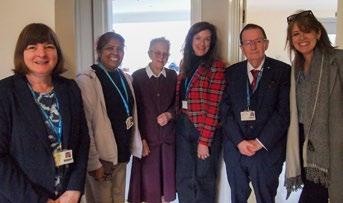
Sr Christine Charlwood, RA (centre) and colleagues L to R Dr Caroline Healy, Thanuja Michael, Dr Cindy Harper, Professor John Lydon and Sarah Green.
As part of St Mary’University 175th Anniversary, a special ‘Education Dinner’ was held on the evening of Thursday 27th March 2025 to celebrate the legacy of the niversity in education. Invitees were those leaders in the education sector and in the university’s partners schools.
The CES and the Bishops’ Conference have recently published a report on child poverty, drawing on insights from more than 2,000 Catholic schools in England and Wales provided at the end of last year.
It showed over 90% of Catholic schools reporting encountering families struggling with the cost of living, and 70% noted worsening conditions over the past year. Similarly, 88% of Catholic schools observed a strong connection between poverty and poor mental health, with financial instability exacerbating stress, anxiety, and depression among pupils and their families.
Many parents of pupils in Catholic schools are ineligible for Free School Meals due to immigration status or low-paid casual temporary employment, and the report calls for reforms to eligibility criteria to help tackle this. The data also reveals school uniform support to be one of the most common forms of assistance that the Catholic sector provides, with 94% of Catholic schools doing so, among other initiatives such as breakfast clubs.
The results of the latest annual census of Catholic schools have also just been published, providing a detailed picture of the sector. It shows Catholic schools continuing to prove popular with parents and pupils from a wide range of backgrounds, and that staff members from ethnic minorities make up almost a quarter of Catholic school workforces, more than half again the number that other schools employ. Of the 47,312 of employees in England’s 2,074 Catholic schools 24.6% are from ethnic minority backgrounds, compared to a 16.2% national average.
^ 47.2% of ^ 817,784 pupils from ethnic minorites
Nearly half of the 817,784 pupils in England’s state-funded Catholic schools are also from ethnic minorities, at 47.2%, compared with an England state sector average of 38.7%. There are 349,309 non-Catholic pupils, with 45.6% (159,285) from other Christian denominations, 28.5% (99,553) of no religion, and 11.1% (38,770) being Muslim. Overall, 86.2% of pupils are from a faith background, and 75.8% are Christians.
The CES has recently produced two vision documents explaining the role and shape of academy trusts and the education system.
Developed in partnership with the Church of England's National Society for Education and the Confederation of School Trusts (CST), Flourishing Together sets out ten ‘seeds’ necessary for the ecology of human growth within education. It sets out how ‘the best unifying concept around which to build the education system for the coming decades is that of flourishing – flourishing children and flourishing adults in flourishing schools’. Flourishing Together was launched at the CST conference in November.
A specifically Catholic vision document, Called To Flourish In Faith And Hope, explores this understanding more fully from a Catholic educational perspective. It seeks to understand what it is to flourish within five comparable but distinct realms: mission; communion; formation; gifts; and fruitfulness, offering ‘a genuine integration of both human learning and religious faith, around the person of Christ’. Called To Flourish In Faith And Hope was also launched in November.
St Mary’s University and Swansea University are exploring how parental engagement in pupils’ education is understood, supported, and enacted in Catholic schools in England and Wales.

By James Willsher CES Partnership and Communications Manager
^ Increase when compared to Census Digest 2023
^ Decrease when compared to Census Digest 2023
Online surveys are being conducted of parents, school staff, including student teachers, and clergy, as well as in-depth interviews with individuals from each group. Also under way is a review of existing research into parental engagement in children’s learning. St Mary’s is one of four Catholic universities in England, along with Birmingham Newman; Leeds Trinity; and Liverpool Hope.
Laudato Si' Turns Ten
Laudato Si' Schools in Scotland are preparing to celebrate the 10th Anniversary of the Holy Father's encyclical.
As we approach Laudato Si' Week at the end of May, the 200+ Laudato Si' Schools in Scotland will be reflecting on their journey so far, the ways they have met the 7 goals and sharing their messages of hope for their families, schools, communities and the world. We aim to showcase these reflections as part of our Catholic Schools' Festival in June.
Invitation to join "Our journey of Hope" Catholic Schools' Festival Glasgow
Registration is now open for the Catholic Schools' Festival, being hosted on the 14th June 2025 in Glasgow city centre to mark the Jubilee Year. This event is being organised by the Scottish Catholic Education Service, in partnership with the Education offices of the Bishops' Conferences of Ireland and England & Wales, and is one of four events for Catholic Educators to celebrate the Jubilee Year.
The day will be a dynamic celebration of Catholic Education, with the theme of Hope, echoed through all of the sessions. Catholic educators from across Ireland, Scotland, England & Wales are invited to participate in the festival, along with colleagues from Australia and Norway.
Guests and Key Note contributors include: John Swinney, First Minister of Scotland; Professor Tracey Rowland, Notre Dame University Australia; Professor Brother David Hall, Australian Catholic University; Paul Meaney, President of the European Committee for Catholic Education; The St Andrews' Foundation of Glasgow University and school partners from across Scotland.
The festival moves away from the traditional conference style event, and offer participants a timetable that allows them to choose between speakers, dialogue & discovery sessions where they will be in small groups learning about and from other educators, workshops from schools and partners and of course time for prayer, fraternal sharing and the building of our Catholic schools network.
The day includes key speakers who will use the theme “voices of hope” for their sharing; small round table group discussions with the theme “community of hope”; workshops and the sharing of practice under the theme “signs of hope”.
From the very first planning day we wanted to ensure that the day was not just populated with regular prayer, but that there would be a way to have constant prayer happening while we were meeting. To that end, we have intentionally included a theme “Time for hope” and have a hub for prayer that day, led by our schools, for delegates to join in with.
The day concludes with a pilgrim walk through Glasgow city centre, finishing in St Andrew’s Metropolitan cathedral for the celebration of Vigil Mass with the Bishops of Scotland, celebrated by Archbishop Nolan, Archbishop of Glasgow and Bishop President for Education. We will then have the chance to thank guests with a civic reception hosted by the Lord Provost of Glasgow.
For those delegates travelling from other countries to be present at the festival, there is also the opportunity to join a programme of school visits and networking on Friday 13th June. Booking can be made using the QR code. Enquiries can be made to Barbara Coupar, Director of the Scottish Catholic Education Service: director@sces.uk.com

New Education Adviser joins the team at the Scottish Catholic Education Service
The SCES team has recently changed, with the appointment of Joanna Sweeney to the post of Education Adviser. Joanna comes to SCES with a wealth of experience and a unique understanding of the Catholic education system in Scotland.
Joanna studied music at university before going on to qualify as a primary school teacher. After nearly a decade of working within schools across the central belt she was appointed to the post of Religious Education Adviser for primary schools in the Archdiocese of Glasgow. In the nine years of working for the Archdiocese of Glasgow Joanna built strong relationships with the 5 local authorities, head teachers, school staff, families and parishes.
As well as maintaining an annual calendar of high quality CLPL events to meet the professional, vocational and spiritual needs of schools, she has introduced a network of Religious Education coordinators, facilitating their meetings and developing professional learning and quality resources to support excellent RE in schools.
introduce a Diocesan Deputes forum, and
over the years she has strengthened the opportunities and links for Catholic deputes in Glasgow, focussing on formation, peer support and school improvement. She is a founding member of Catholic Deputes Scotland and still sits on their steering group.
Joanna has led the way in progressing new approaches to Sacramental preparation, introducing programmes that link home, school and parish through evangelisation, retreats, learning and prayer all supported by a partnership that encourages and enables teachers and parishioners to lead the programme according to their own context and talents.
She has been instrumental in ensuring that leadership succession is a focus within the Archdiocese and their schools. She has worked with the West Partnership, SCES and local authorities to integrate a Catholic dimension to the successful “Thinking about Headship” and Leadership mentoring work. Joanna has completed the Emerging Leaders fellowship with the Alliance For Catholic Education (through Notre Dame University) and uses her current role to support aspiring and newly appointed leaders at all stages of their profession.
Joanna has been part of the Diocesan team who have successfully engaged with local authorities to ensure that the induction year for NQTS has formal and planned opportunities to reflect the distinctive nature of Catholic schools, including sessions on RSHP and an understanding of Catholic education.
She has developed an expertise in school evaluation and improvement, regularly leading professional learning on “Developing in Faith” and the links to HGIOS. She has been part of the Archdiocesan team that has created bespoke CLPL illustrating the Catholic approach to national educational priorities such as UNCRC, learning for sustainability and RSHP. She is part of the national working groups pilot, that is using a synodal approach to improving support for schools through RE, RSHP and PSE.
Joanna is serving her 2nd term as the Chair of the National Association of Roman Catholic RE advisers, she is a member of the CHAPS national executive, she is part of the Catholic Education Week writing group as well as undertaking many other roles both in a professional and personal capacity.
Joanna was one of the first advisers to

Coventry's Poet Laureate John Bernard paid a visit to his former school to unveil its brandnew library after a five-figure investment and inspire pupils to follow their passion for reading and writing.
Cardinal Wiseman Catholic School, part of the Romero Catholic Academy, welcomed Coventry's Poet Laureate John Bernard for the official opening of its new library, which has undergone a major £70,000 transformation complete with new books and furniture.
The new space will be used by all year groups for lessons, extra-curricular activities, focused reading tuition, and lunchtime clubs, ensuring pupils have regular opportunities to engage with books and develop their literacy skills in an inviting and well-resourced environment.
John said: "It was a real privilege to come back to Cardinal Wiseman, a place that played such an important role in my own journey. Seeing the enthusiasm of the pupils, not just for reading but also for poetry and storytelling, was incredibly inspiring.
John, an acclaimed poet and spoken word artist, also spent time speaking with pupils about the power of words, storytelling, and the importance of reading in unlocking opportunities for the future.
Will Allen at the Romero Catholic Academy said: " We want to ensure that engaging with reading is something pupils carry with them for life, not just as part of their education but as a source of enjoyment, curiosity, and lifelong learning for many years after they leave us."
St John Bosco Art College's choir recently achieved success in the Catholic Schools' Choir of the Year competition, winning first place. Twelve schools across the region entered the competition, and St John Bosco was selected as one of seven choirs to compete in the final.
The event, organised by Joe Watson, choral director for the Archdiocese of Liverpool, took place at the Metropolitan Cathedral in the beautiful crypt concert room.
St John Bosco's choir performed 'Hosanna' by Ligertwood and 'Shine' by Emeli Sandé. In the final rankings, choirs from St Edward's College and St Bede's Catholic High School were placed second and third respectively, with every group receiving high praise for their talent and dedication.
Malcolm McMahon OP, the Archbishop of Liverpool, was the guest of honour and presented the prizes to the winners.
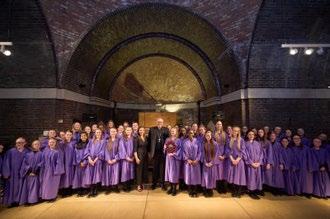
Last year, the Garston-based academy was recognised by the Global School Alliance (GSA) as a 'globally aware school' within the Liverpool City Region, and work soon began to establish a partnership with the new sister
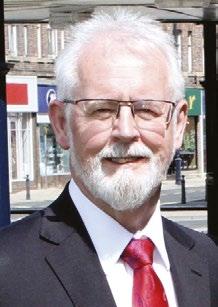
By Willie Slavin MBE
school, Southwest Campus of Shunde No. 1 Middle School.

The sister school shares many similarities with The Academy of St Nicholas. The school boasts a modern, bright, and impressive campus, similar to the academy, but on a much larger scale, with the capacity to accommodate over 3,000 students.
The academy's values of ambition, respect, resilience, and compassion align closely with those of the sister school, alongside a shared vision for high-quality education.
This July, the academy will welcome 30 students and staff from Foshan, who will experience school life and cultural activities in Liverpool. In October 2026, 25 students and staff from St Nicholas will visit Foshan where they will attend school and explore local landmarks, traditions, and cuisine.
The exchange aims to broaden students' perspectives and enhance their cultural awareness. Students will share their experiences through assemblies and workshops, inspiring their peers to embrace global citizenship. To help them prepare, students and staff will receive basic Mandarin lessons and learn about Chinese customs.
Mrs Lindsey Bainbridge, associate assistant headteacher at the academy, will lead the partnership and the exchange.
She commented: "As a modern foreign languages teacher for many years, I've always been passionate about connecting
with schools in different countries to broaden students' horizons and enhance global citizenship.
Schoolchildren and campaigners from across the UK visited Parliament this week to urge MPs to address the global debt crisis which is engulfing many poor countries around the world.
They're calling for a new Debt Justice Law, to create a fairer global system for low-income countries facing insurmountable levels of debt. The aim is to target irresponsible, 'loanshark' behaviour - seen in some private creditors over the years - who are able to avoid accountability but rake in profits from unfair lending to poorer countries, burdening them with debt that can never be repaid.
The result is what's being called a 'global debt crisis', where some of the world's poorest countries are forced to spend more on payments to big banks and hedge funds than on health, education or life-saving climate measures. Fifty-four countries - from Sri Lanka to Kenya - are facing debt distress today.
The parliamentary reception was arranged by CAFOD). Campaigners were able to meet MPs and raise concerns about loans being made by predatory lenders, often at extortionate interest rates. Speakers at the event included Anneliese Dodds, former Minister of State for Development, and Brian Maeba, from CAFOD partner Jesuit Hakimani Centre, who spoke movingly about the debt crisis in his own country:
"Kenya is deeply stuck in debt. Because of the debt crisis, money is going to
paying off debt instead of going to health, education and agriculture. People in Kenya are going to bed hungry and young people can't go to school. That's why we are here today. Together, we can build a future where the burdens of debt no longer weigh heavily on the shoulders of those who can least afford it."
More than 100 children from primary schools in South London were led by Archbishop John Wilson in Eucharistic Adoration at St George's Cathedral in Southwark.
In a short reflection during the period of prayer, Archbishop John explained the importance of the Eucharist to the children gathered. Pointing to the Bible (Matthew 26:26-28; Luke 22:19-21), the Archbishop explained that when Jesus broke the bread and took the cup of wine, and said "this is my Body" and "this is my Blood" the Lord Jesus was telling us: "that in the Eucharist - which is His Body and His Blood - he is with us. He is really and truly there."
The Archbishop added "that is why the Eucharist is so important to us as Catholics. Because Christ is really and truly there. The Eucharist is Jesus himself".
Encouraging the children to regularly return to Eucharistic adoration, Archbishop John said adoration is a "time of prayer, before the Lord Jesus" and it is "our chance to talk with him, to see him and to be with him".
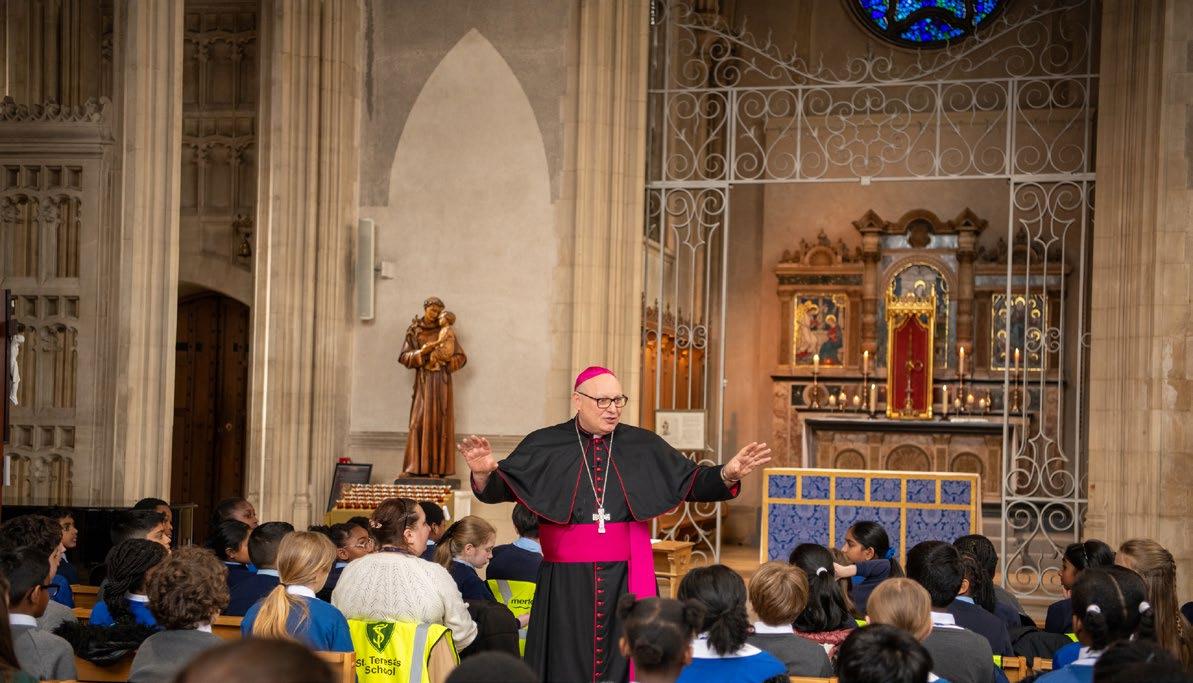
Archbishop speaks with children before the service

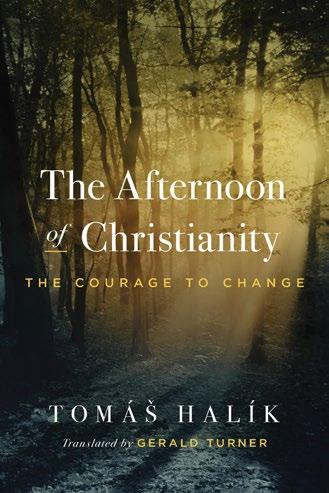
Tomás Halík, The Afternoon of Christianity: the courage to change. University of Notre Dame Press, 2024. Translated by Gerald Turner.
This is a book about faith as a journey in search of God in the midst of a changing world. Christ came not to offer a ’doctrine’ but a journey on which we continually learn to transform our humanity, our way of being human and all our relationships – to ourselves, to others, to society, to nature and to God (p.132).
Tomás Halík is uniquely qualified to map out the journey. A clinical psychologist, Catholic priest, philosopher, pastor and theologian, he is also a professor of sociology at the University of Prague and president of the Czech Christian Academy. He was ordained in the underground church before the fall of Communism and draws deeply on his experience and scholarship to explore the Church’s present crisis and identify emerging signs of change.
The afternoon of the book’s title comes from Carl Jung’s metaphor for the dynamics of human life: childhood is the morning of life, followed by the midday crisis and the afternoon age of
maturity. In the history of Christianity, the morning is the premodern period of building the Church’s institutional and doctrinal structures. Then comes the age of modernity, of secularisation, of shaking up the structures. The postmodern age in which we now live is a call to afternoon Christianity, to greater maturity and depth.
Today, as at every period of significant historical change, Halík argues, the position and role of faith in society and the forms of its cultural self expression are changing. He traces the history of Christianity and its roots in Judaism, the relationships between faith, religion, and culture. The Christian faith has outgrown its previous forms, he concludes, and every attempt to squeeze it back into one of them is counterproductive.
He highlights the unfinished business of the Second Vatican Council, which attempted to reach an understanding with modernity and move the Church from its narrow confessional form towards an ecumenical, global Christianity. As he points out, modernity was already on its way out and the move came too late; the Church’s attempt to achieve unity among Christians, dialogue with other religions and rapprochement with secular humanism never got more than half way. Continuing on this path, he argues, remains a task for the afternoon of Christianity (p.54).
He believes that we are at a Kairos moment, an opportunity to transform the way we think and act. It is no coincidence, he says, that someone who represents the dynamics of the Latin American continent has become pope. (The book is dedicated to Pope Francis ‘with reverence and gratitude’). Halík considers it an ‘urgent task’ for theologians carefully to elaborate Francis’ reformist impulses in the development of synodality and autonomy of local churches. However, he asks if bishops are ready to give up their monarchical conception of their role and become mediators of dialogue within the church. Are they sufficiently prepared to create and defend scope for the exercise of the charisms of individual believers, men and women? Are they ready to recognise the capacity of believers to
share responsibility for communities? The reform of the church, he argues, is about more than changes to institutional structures. It must come from deep spiritual renewal (p.91).
Halík points out that while traditional institutional forms of religion often resemble ‘dried up riverbeds’, interest in spirituality of all kinds is a ‘surging current that is eroding old banks and carving out new channels’. He suggests that the future of churches depends largely on whether, when and to what extent they understand the importance of this shift and how they respond to this sign of the times. Christianity’s task in the afternoon of its history will largely be about the development of spirituality (p.152).
The institutions of the Church ’no longer have the power to control and discipline faith’. But ‘the church as a community of believers, of memory, narrative and celebration has an enduring mission to serve the faith by its historical experience and, above all, by the power of the Spirit who dwells and works even within clay jars’ (p 184).
He identifies four ecclesiological concepts that can help shape this church. First is the concept of the Church as the people of God journeying through history, which was a central element of Vatican II’s ecclesiology. Second, the Church as a school of life and wisdom, where the virtues of faith, hope and love are at the centre of the curriculum. Third, the Church as field hospital, about which Pope Francis has spoken; a church which does not remain behind the walls of certitudes but goes to out to heal wounds and minister to people. Fourth, the Church as a place of encounter and conversation, which offers a ministry of accompaniment and reconciliation. This would involve the creation of spiritual centres; places of adoration and contemplation, where experiences of faith can be shared. If the Church is not to become a self contained sect, Halík argues, it must undertake a ‘radical shift in its self-conception, in its understanding of its service to God and to people in this world’ (p.195).

This ministry of spiritual accompaniment straddles the boundary between the religious and secular spheres; it draws on the spiritual treasures of religion but it lives in a secular space, so it must express itself in a way that is widely understood. Like public theology, it must ‘transcend the boundaries of the church’s language game’ (p.202).
This is an important book from a highly respected author who won the Templeton Prize in 2014 in recognition of his outstanding contributions to theology and his efforts to facilitate interfaith dialogue. In the final paragraph, he reminds us that a new day begins at evening. Let’s not miss the moment, he suggests, when the first star appears in the evening sky.
Posted by Dr Mary Cullen, editor of Open House Scotland · Arts & Culture Published: 1st February 2025
The Road to Emmaus and Beyond
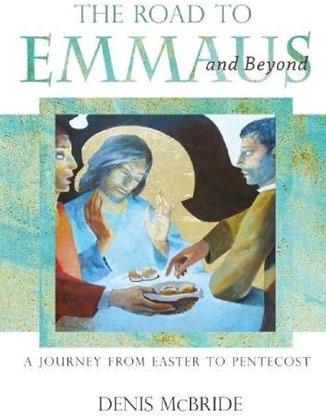
A Journey From Easter to Pentecost Denis McBride C.Ss.R. Redemptorist Publications
Inspired by Pope Francis’ call for ”missionary disciples” in his first apostolic exhortation Evangelii Gaudium, and his previous call for an “evangelising Church that comes out of herself” Fr Denis McBride was drawn to revisit a previous publication Emmaus: the gracious visit of God according to Luke. First published in 1991 and, testament to its quality, gone through four reprints, it seemed to be a book whose time had come.
Where better to find to seek understanding of discipleship with a missionary purpose than in those post resurrection days and weeks culminating in Pentecost. This revised edition, published in April 2018 is now in its second printing.
Luke’s common authorship of the Acts of the Apostles in addition to the Gospel attributed to him, allows this story to move seamlessly from the devastation, trauma and the loss of hope felt by the disciples of Jesus following on from the Crucifixion, through to receiving the gift of the Spirit at Pentecost. The Emmaus story which, as a pivotal event in the unfolding revelation of the Risen Jesus, is forensically examined by the author to gradually uncover, not just the understanding of what the two had experienced, but, by uncovering its meaning, offers enlightenment and a renewed ‘burning’ heart. By being enabled to see scripture in a new light, seeing the Risen Jesus for who he really is, they are taken out of their former selves.
Hospitality and its association with meals is a recurring element of Luke’s Gospel, signified by the two reaching out to the stranger, in itself a practice they had absorbed as followers of Jesus. Occasions of table fellowship offered Jesus opportunities for teaching and forgiveness. In this instance Jesus recalls that the inevitable fate of the prophet was rejection even to death: “Was it not necessary that the Messiah should suffer these things and then enter into his glory?” This following on from “Then beginning with Moses and all the prophets, he interpreted to them all the things about himself in all the scriptures…. When he was at the table with them, he took bread, blessed it and broke, and gave it to them. Their eyes were opened, and they recognised him; and he vanished from their sight….’Were not our hearts burning while he was opening the scriptures to us?’
That same hour they got up and returned to Jerusalem.”
The author, recalling the significance of Jerusalem in Luke’s theology, suggests that the journey made by the two disciples is an “inward one to see if they can make sense of the events for themselves. So, the journey to Emmaus is:
from without to within from confusion to understanding from death to life from blindness to recognition from absence to presence from Jerusalem to Jerusalem from separation to community.
The return to Jerusalem and to a community growing in its recognition and understanding of the Risen Jesus witnesses to a community waiting, fortified by their prayer and worship and breaking of the bread; a recognition that in both the word and the sacrament, God is continuing to speak to them.
In Jesus’ final coming among them he recalls how scriptures had to be fulfilled and concludes with his exhortation “ you are my witnesses of all these things… stay here in this city until you are clothed with the power from on high. Then he lead them out to Bethany and lifting up his hands he blessed them. While he was blessing them, he withdrew and was carried up into heaven.”
The interesting transition from the Gospel to Acts, both bearing the theological marks of Like but moving from within the close community towards the Pentecost experience which markedly denotes the elimination of the gap between event and meaning and between experience and interpretation, now resolved in the experience of the Spirit. The once reluctant witness Peter becomes the great proclaimer of the Risen Jesus and the prominent leader of the emerging Church community through the power of the Spirit. The Spirit becomes the guarantor of the faithfulness of the Church to its founding characteristics, as the author states “it is linked to the past through its sacred memory; it is linked to the present and the future through the dynamism of the Spirit.”
The evidence fulfilling Pope Francis’ wish for an evangelising Church that has come out of herself has its blueprint in the ongoing story of Acts that eloquently witnesses to the dynamism of the early Church fortified by the power of the Spirit.
This book has that rare quality of drawing the reader towards understanding but, pricelessly, draws one into a depth of meaning that kindles the heart.
Willie Slavin
Around this time of year, we’re preparing to celebrate the feasts of The Ascension and Pentecost in our schools and parishes. It’s an especially important time for Missio and its children’s branch, Mission Together, as these solemnities provide a great opportunity to highlight Christ’s call to mission, as relayed in the Ascension (Mt 28:16-20); our solidarity with God’s global Church family; and the encouragement provided by the Holy Spirit, as revealed at Pentecost (Acts 2:1-8, 14-18).
These three essential themes - the call to mission, our solidarity with God's global family, and the Spirit's encouragement - run through all of Mission Together's resources. But they’re especially central to our newly-created and refreshed Ascension and Pentecost materials. We can't wait to share them with you!
Our Ascension Assembly uses scripture and global artwork to teach students about this important feast day. We've included three Biblical accounts of the Ascension (from Acts, Matthew, and Luke) to meet the requirements of the Religious Education Directory for different year groups. Each scripture passage highlights key teachings about the Ascension; with discussion questions to deepen pupil understanding.
We follow a similar format in our new Pentecost Assembly, with added emphasis on Pentecost symbols and feast day traditions from around the world. Because both the Ascension and Pentecost are holy days of obligation, Mission Together has also created Celebrations of the Word to mark these feasts through prayer; especially when a school Mass is not possible.
In keeping with the Prayer and Liturgy Directory guidelines, our Celebrations of the Word include Gospel readings, religious artwork, hymn links, studentled prayers, and a simple reflection. You can confidently explain and explore scriptural references and topical themes of these feast days with students, knowing you have an entire toolkit to hand.
Both the Ascension and Pentecost fall within the RED Branch ‘To the ends of the earth’, which focuses on the power of the Holy Spirit to inspire, encourage, and change lives. Our resources help to deepen pupils’ awareness by encouraging them to reflect upon the lives of saints such as Saint Francis of Assisi, Saint Oscar Romero, and Saint Frances Cabrini, who, led by the Holy Spirit, have helped to build God’s kingdom on earth.
Schools can find out more about these and other holy men and women in our Mission Together Five Fact Assemblies. Each assembly relays fascinating faith stories through five simple but key facts. Our Five Fact Assemblies also include reflective questions, calls to action, scripture and prayer.

We’re also excited to share our new Five Fact Assembly on Fr Thomas Jackson. An early Mill Hill Missionary, Fr Thomas was the originator of the iconic Red Box - Missio's much-loved collection box - which still graces Catholic homes across England and Wales today, and has become a sign of hope in many poor communities around the world.
Born into poverty in 19th century Preston, Thomas taught himself to read. He developed a deep love of the Gospels and was passionate about sharing Christ’s love with the world, and so, sponsored by a priest's housekeeper (a vital act of kindness which later inspired the Red Box), Thomas was ordained a Mill Hill Missionary as a young man, in 1879.
Having never left England before, Thomas was sent to India. From there, he walked 700 miles to Afghanistan, to serve as chaplain during the Second Anglo-Afghan War;
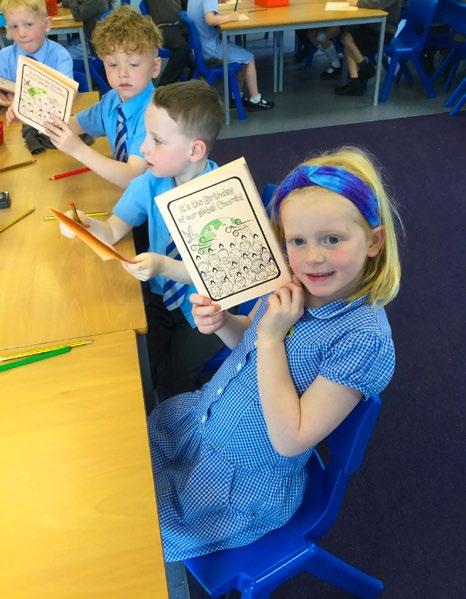




where his courage and compassion earned him a Victoria Cross nomination.
From Afghanistan, Fr Thomas was sent to Borneo. His mission took him hundreds of miles through jungles and swamps. But by treating everyone he met with equal kindness and respect, Fr Thomas was able to establish Borneo's first health clinics and schools in remote regions.
Fr Thomas spent 15 years serving the people of Borneo, and was eventually appointed Apostolic Prefect of Borneo. He then returned to Liverpool, where he developed the Red Box concept to help poor young men train for priesthood.
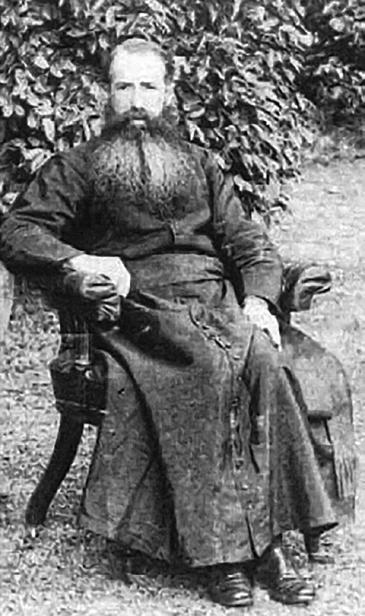

Today, the Red Box supports priest and religious sister formation worldwide, as well as funding churches, schools, feeding programs, and healthcare facilities.
The impact of this support stems from the partnership between Mill Hill Missionaries and Missio England and Wales — part of a global network of 120 Missio offices which support Catholic communities in areas which face poverty and conflict.
Money donated to Mission Together, the children’s branch of Missio, solely funds children’s projects, such as school-sponsorship schemes, youth apprenticeships, and kindergartens. However, as well as funding lifechanging projects overseas, Mission Together also supports the mission of Catholic education in England and Wales, through the provision of free catechetical classroom resources.
THIS SUMMER TERM, LOOK OUT FOR OUR FREE RESOURCES FOR:
Our Lady and the Rosary: Help children deepen their relationship with Mary through our assemblies, activity sheets, comprehension tasks, and rosary guides. Bring pupils and staff together with our Queen of the May Celebration of the Word and Procession plan.
The feast of Saint Peter & Saint Paul:
Explore the lives of these two great missionary saints and inspire children to follow their example by sharing the love and message of Jesus – through prayer and action – with everyone, everywhere.
Day of Many Colours:
This joyful day of prayer and fundraising is based on the five colours of the Mission Rosary. Its aim is to develop in children a missionary spirit of attention towards others; through prayer, charity, and action. Schools can choose any day to host their Day of Many Colours, but we suggest it takes place around the feast of Saint Peter and Saint Paul (29 June).
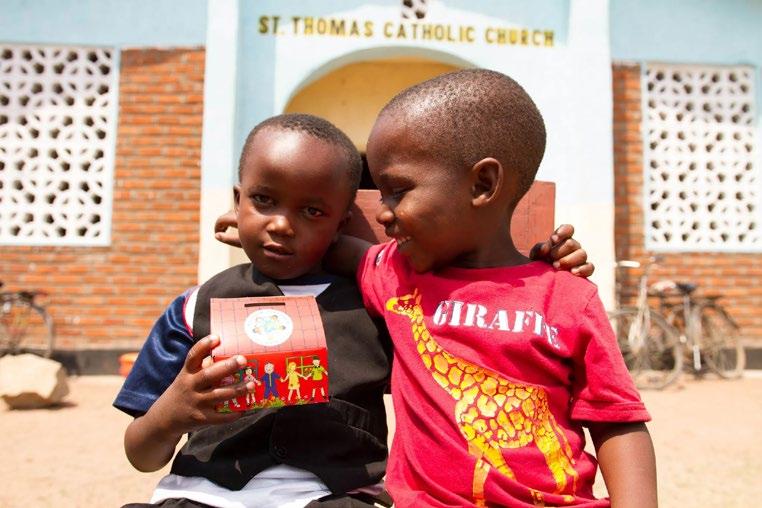
Pilgrims of Hope Jubilee:
2025 is a year of hope! We’ve created a bank of resources to support schools on their journey through this Holy Year. There’s a Celebration of the Word, a Jubilee Five Fact Assembly, activity ideas, and our new, and ever-so-hopeful Pilgrim Calypso song. Joyful dancing is almost inevitable!
missiontogether.org.uk
Whilst Mission Together resources are free, the overseas projects we support rely on your donations and prayers. If you are interested in becoming a Mission Together volunteer, either delivering assemblies or being part of our Consultancy Board, we’d love to hear from you. Please contact Claire at: missiontogether@missio.org.uk
